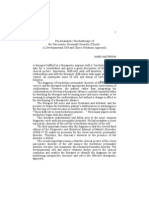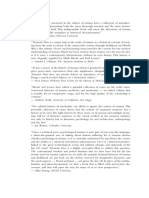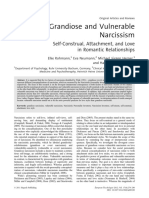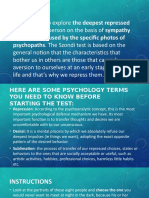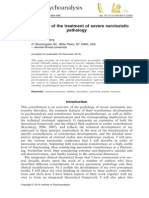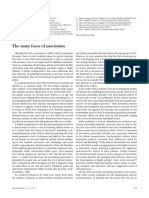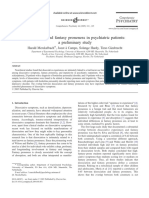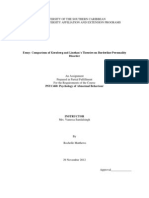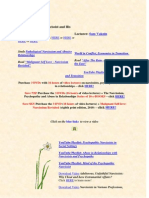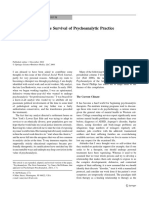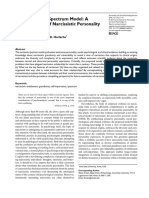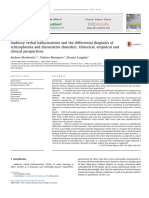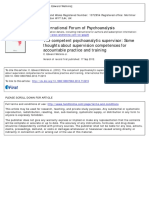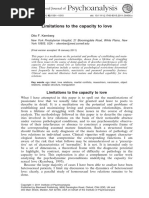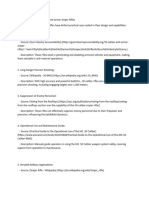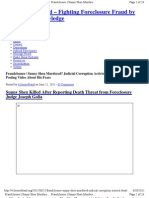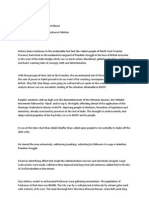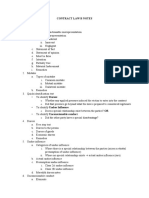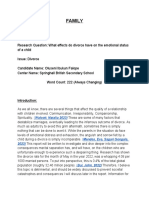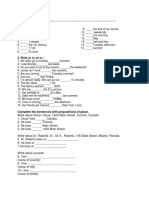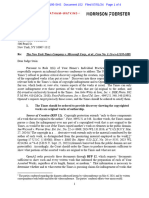Cain, Pincus, Ansell, 2008 Narcissism at The Crossroads, Phenotypic Description of Pathological
Cain, Pincus, Ansell, 2008 Narcissism at The Crossroads, Phenotypic Description of Pathological
Uploaded by
juaromerCopyright:
Available Formats
Cain, Pincus, Ansell, 2008 Narcissism at The Crossroads, Phenotypic Description of Pathological
Cain, Pincus, Ansell, 2008 Narcissism at The Crossroads, Phenotypic Description of Pathological
Uploaded by
juaromerOriginal Title
Copyright
Available Formats
Share this document
Did you find this document useful?
Is this content inappropriate?
Copyright:
Available Formats
Cain, Pincus, Ansell, 2008 Narcissism at The Crossroads, Phenotypic Description of Pathological
Cain, Pincus, Ansell, 2008 Narcissism at The Crossroads, Phenotypic Description of Pathological
Uploaded by
juaromerCopyright:
Available Formats
Available online at www.sciencedirect.
com
Clinical Psychology Review 28 (2008) 638 656
Narcissism at the crossroads: Phenotypic description of pathological narcissism across clinical theory, social/personality psychology, and psychiatric diagnosis
Nicole M. Cain a,, Aaron L. Pincus a , Emily B. Ansell b
a b
The Pennsylvania State University, United States Yale University School of Medicine, United States
Received 5 March 2007; received in revised form 18 September 2007; accepted 24 September 2007
Abstract This review documents two themes of emphasis found in phenotypic descriptions of pathological narcissism across clinical theory, social/personality psychology, and psychiatric diagnosis. Clinical theories of narcissism spanning 35 years consistently describe variations in the expression of pathological narcissism that emphasize either grandiosity or vulnerable affects and selfstates. Recent research in social/personality psychology examining the structure of narcissistic personality traits consistently finds two broad factors representing GrandiosityExhibitionism and VulnerabilitySensitivityDepletion respectively. However, the majority of psychiatric criteria for narcissistic personality disorder (NPD) in the Diagnostic and Statistical Manual of Mental Disorders (DSM-IV; American Psychiatric Association, 1994) emphasize expressions of grandiosity. By placing most of the diagnostic emphasis on overt grandiosity, DSM NPD has been limited by poor discriminant validity, modest levels of temporal stability, and the lowest prevalence rate on Axis II. Despite converging support for two phenotypic themes associated with pathological narcissism, psychiatric diagnosis and social/personality psychology research often focus only on grandiosity in the assessment of narcissism. In contrast, clinical theory struggles with a proliferation of labels describing these broad phenotypic variations. We conclude that the construct of pathological narcissism is at a crossroads and provide recommendations for diagnostic assessment, clinical conceptualization, and future research that could lead to a more integrated understanding of narcissistic personality and narcissistic personality pathology. 2007 Elsevier Ltd. All rights reserved.
Contents 1. 2. Clinical theories of narcissism . . . . . . . Narcissism in social/personality psychology 2.1. Self-regulation theory . . . . . . . . 2.2. Empirical associations of the NPI . . 2.3. NPI scores and self-esteem . . . . . 2.4. Pathological narcissism and the NPI . . . . . . . . . . . . . . . . . . . . . . . . . . . . . . . . . . . . . . . . . . . . . . . . . . . . . . . . . . . . . . . . . . . . . . . . . . . . . . . . . . . . . . . . . . . . . . . . . . . . . . . . . . . . . . . . . . . . . . . . . . . . . . . . . . . . . . . . . . . . . . . . . . . . . . . . . . . . . . . . . . . . . . . . . . . . . . . . . . . . . . . . . . . . . . . . . . . . . . . . . . . . . . . . . . . . . . . . . . . . . . . 640 642 643 643 643 644
Corresponding author. E-mail address: nmc179@psu.edu (N.M. Cain). 0272-7358/$ - see front matter 2007 Elsevier Ltd. All rights reserved. doi:10.1016/j.cpr.2007.09.006
N.M. Cain et al. / Clinical Psychology Review 28 (2008) 638656
639
Social/personality research beyond the NPI . . 2.5.1. Structural studies. . . . . . . . . . . 2.5.2. Alternative constructs and measures . 3. DSM narcissistic personality disorder . . . . . . . . 3.1. Criteria for NPD in DSM-III, DSM-III-R, and 3.2. Evaluations of DSM NPD . . . . . . . . . . 3.2.1. Prevalence . . . . . . . . . . . . . . 3.2.2. Internal consistency . . . . . . . . . 3.2.3. Temporal stability . . . . . . . . . . 3.2.4. Discriminant validity . . . . . . . . . 4. Narcissism at the crossroads . . . . . . . . . . . . . References . . . . . . . . . . . . . . . . . . . . . . . . .
2.5.
. . . . . . . . . . . . . . . . . . . . DSM-IV . . . . . . . . . . . . . . . . . . . . . . . . . . . . . . . . . . .
. . . . . . . . . . . .
. . . . . . . . . . . .
. . . . . . . . . . . .
. . . . . . . . . . . .
. . . . . . . . . . . .
. . . . . . . . . . . .
. . . . . . . . . . . .
. . . . . . . . . . . .
. . . . . . . . . . . .
. . . . . . . . . . . .
. . . . . . . . . . . .
. . . . . . . . . . . .
. . . . . . . . . . . .
. . . . . . . . . . . .
. . . . . . . . . . . .
. . . . . . . . . . . .
. . . . . . . . . . . .
. . . . . . . . . . . .
. . . . . . . . . . . .
. . . . . . . . . . . .
. . . . . . . . . . . .
. . . . . . . . . . . .
. . . . . . . . . . . .
. . . . . . . . . . . .
. . . . . . . . . . . .
. . . . . . . . . . . .
. . . . . . . . . . . .
. . . . . . . . . . . .
645 645 645 647 647 648 648 648 649 649 650 651
The inclusion of narcissistic personality disorder (NPD) on Axis II of the third edition of the Diagnostic and Statistical Manual of Mental Disorders (DSM-III; American Psychiatric Association, 1980) and its subsequent revisions (DSM-III-R; American Psychiatric Association, 1987; DSM-IV, American Psychiatric Association, 1994; DSM-IV-TR; American Psychiatric Association, 2000) stimulated increased interest in the construct of narcissism across fields. Significant advances in the last 35 years coalesce into three main bodies of literature (Ronningstam, 2005a,b): clinical theories and case studies of normal and pathological narcissistic personality functioning and psychotherapeutic intervention; social/personality psychological theory and research focusing on narcissistic traits, most often in non-clinical samples and contexts; and finally, investigations based on DSM criteria sets and related diagnostic features of NPD. A comprehensive understanding of narcissism would ideally reflect convergences across these areas. However, in the review that follows, we find that each of these three domains has internal problems with conceptualization and assessment, and little coordination with their counterparts. This review also identifies some significant, but often unrecognized areas of convergence. In particular, we found two themes of emphasis in the phenotypic descriptions of pathological narcissism across clinical theory, social/personality psychology, and earlier versions of DSM NPD criteria. Clinical theories of narcissism consistently describe variations in the expression of narcissistic pathology that emphasize either narcissistic grandiosity or narcissistic vulnerability. Similarly, research in social/personality psychology examining the structure of narcissistic personality traits consistently finds two broad factors of narcissistic grandiosity and narcissistic vulnerability. Despite this convergence between clinical theory and social/personality psychology, research suggests that the majority of psychiatric criteria for NPD in DSM-IV emphasize expressions of grandiosity and lack representation of narcissistic vulnerability. As the development of DSM-V begins in earnest (e.g., First et al., 2004; Kupfer, First, & Reiger, 2002; Widiger, Simonsen, Krueger, Livesley, & Verheul, 2005), the lack of coordination between clinical conceptualizations of pathological narcissism, research on narcissistic personality traits, and psychiatric diagnosis of NPD puts the study of narcissism at a crossroads. This situation is unfortunate in light of the links reported between narcissism and related areas of psychopathology and dysfunction: DSM Axis I disorders (Bachar, Hadar, & Shalev, 2005; Ronningstam, 1996), psychopathy (Paulhus & Williams, 2002; Ronningstam, 2005b), interpersonal problems and relational dysfunction (Campbell, Foster, & Finkel, 2002; Carroll, Hoenigmann-Stoval, King, Weinhold, & Whitehead, 1998; Dickinson & Pincus, 2003; Ehrenberg, Hunter, & Elterman, 1996; Rhodewalt & Morf, 1995; Wiehe, 2003), substance use and abuse (Luhtanen & Crocker, 2005; Vaglum, 1999), aggression and sexual aggression (Baumeister, Catanese, & Wallace, 2002; Baumeister, Smith, & Boden, 1996; Bushman & Baumeister, 1998; Bushman, Bonacci, van Dijk, & Baumeister, 2003), impulsivity (Vazire & Funder, 2006), and suicidal behavior (Links, Gould, & Ratnayake, 2003; Ronningstam & Maltsberger, 1998). Action must be taken to resolve disjunctions and integrate findings in future conceptualizations of pathological narcissism or these efforts will impede their own progress towards a more sophisticated understanding of narcissism (e.g., Blais, 2005; Michels, 2005; Morey, 2005; Watson, 2005). It is important to note that this review focuses on evolving conceptualizations of narcissism (i.e., phenotypic descriptions) across clinical theory and practice, social/personality research, and psychiatric diagnosis. We chose to examine convergences and divergences in phenotypic description across these domains for two reasons. First,
640
N.M. Cain et al. / Clinical Psychology Review 28 (2008) 638656
phenotypic description is an important component in the diagnosis, assessment, and treatment of psychopathology. We hope this review expands awareness of the emerging trends in the conceptualization of pathological narcissism as related to the diagnostic criteria. Second, we hope this review also articulates some of the choices facing investigators thereby increasing coordination of empirical research on all aspects of narcissism. This review is an attempt to provide an integrative perspective at a level that is complementary to more focal reviews of assessment of NPD (Hilsenroth, Handler, & Blais, 1996) and more general reviews of Cluster B personality disorders (Kraus & Reynolds, 2001). We limit our review to the literatures in each of the three domains that best address issues of phenotypic description and thus do not comprehensively review the literatures on etiology, assessment methodology, psychotherapy process and outcome, or categorical vs. dimensional classification. This focus requires a brief clarification of terminology. Across the literature reviewed, authors used different terms to discuss variation in phenotypic description of narcissism. Some terms imply underlying categorical assumptions (e.g., subtypes), while others imply dimensional assumptions (e.g., factors). We reviewed literature from both perspectives and do not advocate for either position here. We could not identify a satisfactory neutral term that referred to phenotypic variation and thus elected to retain the terms used when reviewing the original literature. Whether the variations in phenotypic description reviewed here are optimally conceptualized as categories, dimensions, or prototypes is beyond the scope of this paper and should be determined by future investigations. We do suggest that for pathological narcissism, interdisciplinary coordination of research and treatment could be improved by an increased awareness of the construct's breadth. Finally, our review concludes with the recommendation that the two broad themes of grandiosity and vulnerability found in the literature can serve as useful starting points for evolving conceptualizations of narcissism. 1. Clinical theories of narcissism In the last 35 years, the expanding clinical literature on narcissism and narcissistic personality pathology has led to a marked proliferation of labels implying variations in the phenotypic expression of narcissism. We identified over 50 distinct labels describing variability in the expression of pathological narcissism. While each individual conceptualization has unique clinical value, neither future classification systems (e.g., DSM-V), nor intervention models, are likely to sustain such a level of diversity in diagnostic discrimination nor is it clear that such continued parsing would facilitate an integrative understanding of pathological narcissism. However, an initial conceptual analysis of these phenotypic variations suggests that two broad descriptive themes of dysfunction are consistently found in the clinical literature. One theme reflects an emphasis on grandiose aspects of narcissism and a second theme reflects an emphasis on vulnerable aspects of narcissism (see Table 1). It is important to note that conceptual analysis alone is not enough to determine an optimal set of characteristics to fully describe narcissistic personality pathology. Empirical research is necessary to explore the wide variability found in the clinical literature and to determine the optimal representation of pathological narcissism in both substance and form. Rather than review each contribution listed in Table 1, we instead focus this section on how clinical theorists have used the themes of grandiosity and vulnerability to describe the core aspects of narcissistic dysfunction through defects in self-structure, self-esteem dysregulation, affect dysregulation, maladaptive defensive strategies, and difficulties in the therapeutic relationship. Clinical theorists, such as Kohut (1971, 1977) and Kernberg (1984, 1998), have conceptualized narcissism as a normal aspect of self-development that evolves as the individual matures. Within this conceptualization of normal narcissism, adults regularly have narcissistic needs that require age-appropriate provisions to support and maintain selfcohesion and a realistic sense of self-esteem. Pathological narcissism, on the other hand, is believed to develop when there is a defect in the normal progression of self-development, resulting in an inability to maintain self-cohesion and increased self-esteem dysregulation. To Kohut (1971, 1977), problems in early self-development occur when nonempathic responses are received from the selfobjects of infancy and childhood. The early self employs narcissistic defenses to ward off feelings of inadequacy that occur when the individual does not have his/her grandiose self mirrored by others or when the individual becomes overwhelmed by their own grandiose self-expectations. These narcissistic defenses from Kohut's theory involve two forms of splitting that represent the themes of grandiosity and vulnerability. The first form, horizontal splitting, is similar to repression in that it involves the barring of unacceptable selfobject needs and concerns from consciousness. The individual is thus able to maintain overt displays of grandiosity while chronically denying any feelings of low self-esteem or shame. In contrast, vertical splitting uses denial and
N.M. Cain et al. / Clinical Psychology Review 28 (2008) 638656 Table 1 Phenotypic labels for pathological narcissism and their thematic emphases Source Kohut (1971) Bursten (1973) Grandiose themes Horizontal split Manipulative Phallic Paranoid Mirror-hungry Alter-ego DSM-III NPD Overt Egotistical Pathological Malignant Thick-skinned DSM-III-R NPD Oblivious Overtly Grandiose Exhibitionistic Uncivilized spoiled child Special child DSM-IV NPD Empowered Manipulative Classical Unprincipled Amorous Elitist Fanatic TANS Arrogant Psychopathic Vulnerable themes Vertical split Craving
641
Kohut and Wolf (1978) APA (1980) Cooper (1981), Akhtar and Thomson (1982) Broucek (1982) Kernberg (1984) Rosenfeld (1987) APA (1987) Cooper (1988) Gabbard (1989) Gersten (1991) Masterson (1993) Fiscalini (1993) APA (1994) Cooper and Maxwell (1995) Hunt (1995) Millon (1996)
Ideal-hungry Contact-shunning Covert Dissociative
Thin-skinned NarcissisticMasochistic Hypervigilant Overtly Vulnerable Closet Infantilized spoiled child Shamed child Disempowered Diffident Compensatory
Simon (2002) Akhtar (2003) Ronningstam (2005b)
Shy Shy
disavowal of needs, allowing the conscious experience of vulnerability and helplessness to alternate with feelings of omnipotence. Individuals employing vertical splitting exhibit narcissistic vulnerability through their access to chronic feelings of emptiness, low self-esteem, and shame (see also Kohut & Wolf, 1978). Kernberg's (1984, 1998) conceptualization of pathological narcissism is embedded within his structural model of personality and generally reflects themes of narcissistic grandiosity. According to Kernberg, the narcissistic individual libidinally invests in an abnormal grandiose self based on immature real and ideal self-representations, as well as ideal object-representations. Devalued or aggressively determined self- and object-representations are split off or projected. A pathological grandiose self is constructed by combining all of the positive and idealized characteristics of the self and others, resulting in an unrealistic self-image. To maintain this inflated but fragile self-esteem, the pathological narcissist will defensively avoid awareness of negative aspects of self and others thereby presenting a grandiose self. Kernberg suggests that pathological narcissism ranges in severity as a function of the level of aggression infused within the personality structure. As aggression increases, narcissistic pathology ranges from narcissistic personality disorder to malignant narcissism to psychopathy (see also Kernberg & Caligor, 2005). Incorporating both grandiose and vulnerable themes of narcissistic dysfunction, Ronningstam (2005a,b) identified subtypes of narcissistic personality based on similarities and differences in self-esteem dysregulation, affect dysregulation, and difficulties in interpersonal relationships. Grandiose themes are emphasized in descriptions of the arrogant narcissist and the psychopathic narcissist. The former copes with self-esteem dysregulation by creating an exaggerated sense of superiority and uniqueness as well as by engaging in grandiose fantasies. These individuals exhibit entitlement, exploitativeness, and a lack of empathy as well as experience intense envy and aggression as a result of their affect dysregulation. The psychopathic narcissist copes with self-esteem dysregulation by engaging in antisocial behaviors to protect or enhance their inflated self-image. Such individuals will commit violent criminal acts
642
N.M. Cain et al. / Clinical Psychology Review 28 (2008) 638656
in order to gain admiration from others, display extreme rage reactions to criticism, and are interpersonally sadistic without experiencing remorse or empathy. Consistent with Akhtar's (2003) description of narcissistic vulnerability, Ronningstam's shy narcissist deals with self-esteem dysregulation by engaging in grandiose fantasy while also feeling intense shame regarding their needs and ambition. The dominant affect problem for the shy narcissist is shame rather than envy or aggression, and they avoid interpersonal relationships because of hypersensitivity to rejection and criticism. As seen in Table 1, several clinical theorists have articulated distinct phenotypic descriptions of narcissistic personalities differentiated by their use of defensive strategies reflecting either grandiose or vulnerable themes. These strategies are used in response to stressors, such as shame (e.g. Broucek, 1982), trauma (e.g. Hunt, 1995; Simon, 2002), unfulfilled needs (e.g. Bursten, 1973), or dependency (e.g. Cooper & Maxwell, 1995). Masterson's (1993) influential theory delineates two types of narcissistic pathology: the exhibitionistic and closet personalities, based on differing reactions to abandonment depression. The exhibitionistic personalities have an inflated, grandiose self-perception. They expect that their grandiosity will be mirrored by others and they devalue others who fail to admire them. Alternatively, the closet personalities have a deflated, inadequate self-perception and experience chronic feelings of humiliation and rejection, evoking the vulnerability theme echoed across theorists. Grandiose and vulnerable themes of narcissistic dysfunction also differentially impact the therapeutic relationship (Gabbard, 1989; Rosenfeld, 1987). For example, Gabbard (1998) differentiated two types of narcissistic patients by examining negative transference and countertransference in therapy. The oblivious narcissist may appear distant or disengaged and may devalue their therapy to protect themselves from feeling envious of the therapist. In contrast, the hypervigilant narcissist may be extremely sensitive to others' reactions and may view the therapist as a persecutor if they feel that the therapist is not completely engaged in their session or does not appear to recognize the hypervigilant narcissist's specialness. Finally, Millon (1996, 1998) proposed five subtypes of narcissistic personality disorder based on blends with other pathological personality styles that highlight grandiose and vulnerable themes. Millon's elitist narcissist represents the core, unblended subtype and reflects overriding grandiose themes. These individuals are convinced of their superior self-image and are empowered by their specialness despite few realistic achievements. Another example of Millon's emphasis on grandiose themes is the amorous narcissist, which blends narcissistic and histrionic characteristics, giving rise to an erotic and seductive orientation that builds up the narcissist's sense of self-worth through multiple sexual exploits. In contrast, the subtype of the compensatory narcissist, which blends narcissistic and negativistic or avoidant characteristics, results in individuals who are painfully aware of their inner emptiness. While these individuals may seek to fill this internal void by creating the covert illusion of superiority, they are prone to chronic feelings of shame, humiliation, and anxiety. As exemplified in Table 1, the range of characteristics associated with narcissistic dysfunction found in the clinical literature suggests broad variation in the phenotypic expression of pathological narcissism. However, clinical theory alone is insufficient to determine the optimal set of diagnostic criteria necessary to effectively identify the core of pathological narcissism. Empirical research is also needed to evaluate the value of the numerous characteristics identified in the literature. Our conceptual analysis here suggests that the characteristics articulated in the clinical literature generally emphasize the two broad themes of grandiosity and vulnerability and these two themes can serve as starting points for advancing the empirical understanding of pathological narcissism. As seen in the next section, the themes of grandiosity and vulnerability also converge with structural research on narcissistic traits in social/personality psychology. 2. Narcissism in social/personality psychology The publication of NPD on DSM-III Axis II also stimulated research on narcissistic personality traits in social and personality psychology. The publication of the Narcissistic Personality Inventory (NPI; Raskin & Hall, 1979, 1981) followed on the heels of DSM-III and provided a self-report measure derived from criteria presented in DSM-III. For over two decades, the NPI has dominated social/personality research on narcissistic personality traits. We conducted PsychInfo literature searches from 1985 to 2006 with the known self-report narcissism inventories as keywords to investigate relative frequency of use. We ran several searches with varying parameters (e.g., limited to flagship personality and social psychology journals, all journals, abstract searches, keyword searches, body searches). Results varied in absolute numbers of articles identified, but ratios remained markedly similar. Since 1985, the NPI was used as
N.M. Cain et al. / Clinical Psychology Review 28 (2008) 638656
643
the main or only measure of narcissistic traits in approximately 77% of social/personality research on narcissism (see also del Rosario & White, 2005). Thus, the conceptualization of narcissism has been significantly impacted by the immense body of research using the NPI. It is beyond the scope of this paper to review all of the valuable contributions of the NPI literature and instead, we focus our review on three main areas of NPI research relevant to pathological narcissism: the self-regulation theory of narcissistic functioning, the relevant empirical associations of the NPI, and the relationship between NPI scores and self-esteem. 2.1. Self-regulation theory Research conducted by Morf and colleagues using the NPI has led to an important and valuable self-regulation theory of narcissistic functioning which suggests that the self-regulation concerns of individuals with high NPI scores are driven largely by goals related to affirming their grandiose sense of self (Morf & Rhodewalt, 2001). Morf and colleagues have demonstrated that individuals with high NPI scores are highly invested in promoting their selfperceived superiority and are hypervigilant toward detecting and trying to diffuse potential threats to their grandiose self-perception. For example, such individuals have been shown to respond with self-protective behaviors, such as derogation or devaluation, when threatened by comparison to a better performing other (e.g. Morf & Rhodewalt, 1993) or by negative feedback (e.g. Kernis & Sun, 1994). The self-regulation theory of narcissistic functioning also converges with the two broad themes of dysfunction identified in the clinical literature. Morf (2006) recognized the grandiose and vulnerable aspects of narcissism by suggesting that while narcissists possess an overtly, highly positive sense of self, they also simultaneously possess a covertly fragile and vulnerable sense of self making them constantly dependent on obtaining validation and affirmation from their social environment and interpersonal relationships. 2.2. Empirical associations of the NPI NPI research examining associations with other personality characteristics relevant to pathological narcissism provides empirical confirmation of several elements found in phenotypic descriptions of narcissism. The results of both experimental and correlational research describe individuals with high NPI scores as being manipulative, selfenhancing, prone to aggression, and exhibiting a dominant interpersonal style. For example, Paulhus and Williams (2002) reported overlap between high NPI scores and high scores on measures of psychopathy and Machiavellianism. Bushman and Baumeister (1998) found that high NPI scores are associated with controlling behavior and even intense anger or aggression when the narcissist's expectations are not met. Paulhus (1998) reported that the grandiose selfenhancement style associated with high NPI scores leads to hostility and interpersonal rejection. This description found in the empirical literature clearly converges with aspects of DSM NPD and narcissistic grandiosity described in clinical theory. In fact, some investigators have suggested that the NPI assesses subclinical narcissism (e.g., Paulhus & Williams, 2002; Wallace & Baumeister, 2002). However, research also suggests that the narcissism identified by the NPI is a predominantly adaptive narcissism (e.g. Watson, Trumpeter, O'Leary, Morris, & Culhane, 20052006), generally unlike pathological narcissism with its associated functional impairment (Miller & Campbell, in press; Miller, Campbell, & Pilkonis, 2007). For example, Rhodewalt and Morf (1995) found that Neuroticism was negatively related to high NPI scores. Watson, Little, Sawrie, and Biderman (1992) also found that the adaptive narcissistic traits measured by the NPI, such as leadership/authority, tended to predict greater self-esteem and lower levels of depression. Several researchers have pointed out that the content of the NPI total score may reflect a confusing mix of adaptive and maladaptive content (e.g., Emmons, 1984, 1987; Watson, 2005; Watson et al., 1992; Watson, Varnell, & Morris, 1999-2000) with the latter being limited to the traits of entitlement and exploitativeness. This mix of content has led investigators to manipulate NPI total scores in various ways in order to assess both healthy and unhealthy forms of narcissism (e.g., Horton, Bleau, & Drwecki, 2006). However, it is not clear that manipulation of the NPI can successfully encompass pathological or subclinical narcissism in its entirety. 2.3. NPI scores and self-esteem Subjective reports of positive or negative self-esteem appear to be a primary characteristic differentiating narcissistic grandiosity and narcissistic vulnerability. Raskin, Novacek, and Hogan (1991a) examined the associations of two types
644
N.M. Cain et al. / Clinical Psychology Review 28 (2008) 638656
of self-enhancement, grandiose vs. need for approval self-enhancement, with NPI scores and self-esteem. Analyses indicated that narcissism was independently linked to both grandiose self-enhancement and self-esteem. However, need for approval self-enhancement was not associated with narcissism. In a follow-up study, Raskin, Novacek, and Hogan (1991b) found that grandiose self-enhancement and dominance mediated the pathway between narcissism and self-esteem. In addition, Brown and Zeigler-Hill (2004) found that associations between self-esteem and narcissism depend on a given self-esteem measure's overlap with dominance. The more a measure of self-esteem is correlated with dominance, the higher the correlation is with the NPI. They found that controlling for the variance related to dominance significantly reduced the association between self-esteem and narcissism for six measures of self-esteem. Sedikides, Rudich, Gregg, Kumashiro, and Rusbult (2004) examined mediational pathways between narcissism, self-esteem and good psychological health and found that self-esteem fully accounted for the relation between narcissism and psychological health (p.400). This line of research emphasizes the role that dominance and self-enhancement play in explaining the connection between NPI scores and self-esteem and well-being. Thus, narcissistic traits assessed by the NPI include adaptive characteristics that are inherent in positive self-esteem. The complex relationship of NPI scores with self-esteem and dominance is further highlighted by recent research addressing the argument that the narcissistic individual presents a false mask of high self-esteem. For example, Zeigler-Hill (2006) found that individuals with high NPI scores have high levels of discrepant self-esteem (i.e. high explicit and low implicit self-esteem). Campbell, Bosson, Goheen, Lakey, and Kernis (2007) determined that NPI scores exhibited varied associations with explicit and implicit measures of self-esteem when the measures balanced agentic and communal self-views. Specifically, all agentic, or dominant aspects of self-esteem, were consistently related to high NPI scores and demonstrated that, when it comes to agentic expressions of self-esteem, narcissistic individuals experience high explicit and high implicit self-esteem. 2.4. Pathological narcissism and the NPI The expansive research conducted using the NPI is well-done and is particularly informative regarding selfregulation hypotheses and maladaptive interpersonal behavior associated with pathological narcissism. However, several issues may limit the generalizability of NPI-based research to comprehensively inform clinical understandings of pathological narcissism. Based on the empirical literature, we find that the NPI measures the more grandiose aspects of narcissism, including their adaptive expressions, and may not represent the full spectrum of pathological narcissism identified in clinical theory. Additional limitations to using the NPI as a measure of subclinical narcissism should also be considered. Unfortunately there are currently no studies that compare clinical and normal populations on the NPI to support the view that it assesses subclinical narcissism. It remains unclear whether the empirical associations found for NPI scores would extend to a clinical population. In addition, research using the NPI has predominantly been limited to self-report responses to the instrument. In a series of studies investigating self- and peer-reports of personality pathology, Oltmanns, Turkheimer and colleagues found limited cross-source convergence (Clifton, Turkheimer, & Oltmanns, 2004, 2005; Klonsky, Oltmanns, & Turkheimer, 2002; Oltmanns, Turkheimer, & Strauss, 1998; Thomas, Turkheimer, & Oltmanns, 2003) and demonstrated that self- and peer-reported personality pathology provided relatively independent, incremental contributions to behavioral prediction (Fiedler, Oltmanns, & Turkheimer, 2004; Oltmanns, Melley, & Turkheimer, 2002). Interestingly, discrepancies between prediction of social functioning by self- and peer-reported personality pathology were greatest for narcissistic pathology, leading Oltmanns et al. (2002) to conclude, Peers clearly see something different than the target person when it comes to the symptoms of narcissistic PD (p. 449). Peers typically rated targets as exhibiting more narcissistic pathology than target's self-reports indicated (Clifton et al., 2005) and NPD exhibited the lowest selfpeer correlation of any personality disorder (Oltmanns et al., 2002). Finally, the NPI has a number of psychometric limitations that leave us cautious in interpreting research using the measure in non-clinical contexts as comprehensively describing pathological narcissism. The NPI item pool was initially derived to reflect DSM-III NPD criteria (Raskin & Hall, 1981). However, it is not clear if the NPI item pool taps a sufficient range of pathological narcissistic characteristics as defined by clinical theory or by diagnostic criteria. One such example of this is seen in studies examining the factor structure of the NPI. The NPI has exhibited an unstable factor structure, with 3- (Kubarych, Deary, & Austin, 2004), 4- (Emmons, 1987), and 7- (Raskin & Terry, 1988) factor solutions reported. Of these, only Raskin and Terry (1988) felt their 7 factors reflected DSM NPD criteria. Alternatively, a more recent and more statistically rigorous confirmatory factor analysis (Kubarych et al., 2004)
N.M. Cain et al. / Clinical Psychology Review 28 (2008) 638656
645
suggested three possible factors: power, exhibitionism, and being a special person. These three factors highlight the restricted range of narcissism found in the NPI and suggest that some of the DSM NPD criteria, such as grandiose fantasies, excessive need for admiration, envy, and lack of empathy are not necessarily present in the NPI. In addition to the instability of the factor structure, almost none of the subscales derived from these various factor structures exhibits acceptable levels of reliability (del Rosario & White, 2005), limiting their validity and restricting NPI use to its full scale total score. Recently, a shortened unidimensional version of the NPI was introduced (NPI-16; Ames, Rose, & Anderson, 2006) to address this limitation by reducing reliance on subscales with low reliability. This may indeed improve NPI psychometrics, but also continues to reduce the complex construct of narcissism to a single trait score. The corpus of social-personality research on narcissistic traits in non-clinical contexts is informative and certainly makes a significant contribution to the understanding of pathological narcissism. However, we suggest caution in developing the phenotypic description of pathological narcissism in social/personality psychology on the basis of selfreported responses to the NPI alone given the content and psychometric issues reviewed. Social/personality research has been dominated by efforts to measure traits associated with overt grandiose attitudes and behaviors (e.g., exploitativeness, entitlement, arrogance, etc.). Such traits are fundamental to pathological narcissism, but as this review demonstrates, they may also be limited in scope. Additional research on the factor structure of other narcissism scales suggests that grandiosity is not the only component identifiable in narcissistic personality measures. 2.5. Social/personality research beyond the NPI 2.5.1. Structural studies Structural evaluations of self-report measures of narcissism that included measures beyond the NPI consistently found evidence for 2 molar dimensions (Rathvon & Holmstrom, 1996; Wink, 1991, 1996; Wink & Donahue, 1997). Wink (1991) submitted six MMPI derived narcissism scales to a principal components analysis with varimax rotation and found two orthogonal components. The first component, labeled VulnerabilitySensitivity, had loadings from three scales: the Narcissistic Personality Disorder Scale (NPDS; Ashby, Lee, & Duke, 1979), the Serkownek Narcissistic Hypersensitivity Scale (SNHS; Serkownek, 1975), and the Ego-Sensitivity Scale (Pepper & Strong, 1958). The second component, labeled GrandiosityExhibitionism, had loadings from three scales: The RN-Narcissism Scale (Raskin & Novacek, 1989); the MMPI Narcissistic Personality Disorder Scale (Morey, Waugh, & Blashfield, 1985), and the WG-Narcissism Scale (Wink & Gough, 1990). Self- and informant-reports indicated that both components were related to the following adjectives: bossy, intolerant, cruel, argumentative, opportunistic, rebellious, conceited, arrogant, demanding, temperamental, loud, and dishonest. Only the VS component was positively correlated with the descriptors worrying, emotional, defensive, anxious, bitter, tense, complaining, dissatisfied, and moody, and negatively correlated with mature, dependent, and contented. Only the GE component was positively correlated with the descriptors aggressive, hardheaded, outspoken, restless, show-off, assertive, egotistical, determined, evasive, impulsive, and self-centered and negatively correlated with modest. Wink (1991, 1996) related the GE component with overt narcissism and the VS component to covert narcissism. Wink and Donahue (1997) found boredomproneness to be related to both forms of narcissism, but in different ways. The GE component was related to restlessness and feelings of impatience in response to external constraints on behavior; whereas the VS component was related to difficulties in keeping oneself interested and entertained (lack of internal stimulation), feelings of meaninglessness, and the perception that time is passing by slowly. Rathvon and Holmstrom (1996) followed up Wink's work by submitting the NPI and five MMPI or MMPI-2 based narcissism measures to a principal components analysis. Two orthogonal components were extracted. The first component, labeled Depletion, had loadings from the same three scales as Wink's VS component: the NDPS, the SNHS, and the EgoSensitivity scale. The second component was similar to Wink's GE component; labeled Grandiosity, it had loadings from the NPI, MMPI Narcissistic Personality Disorder Scale (Morey et al., 1985), and the WG-Narcissism Scale (Wink & Gough, 1990). The Grandiosity component was positively related to exhibitionism and negatively related to depression, anxiety, bodily concerns, and social discomfort. The Depletion component was positively related with all MMPI-2 clinical scales and supplemental scales representing anxiety and various forms of maladjustment. 2.5.2. Alternative constructs and measures Our literature search suggested that alternative scales assessing narcissistic personality traits are used infrequently in social/personality research. Until recently, there were few options outside of scales from the MMPI and other omnibus
646
N.M. Cain et al. / Clinical Psychology Review 28 (2008) 638656
clinical inventories. However, a number of additional measures of narcissistic personality traits have appeared in the last 10 years that can expand the scope of assessment. Campbell, Bonacci, Shelton, Exline, and Bushman (2004) developed the Psychological Entitlement Scale (PES) to improve assessment of this core narcissistic trait relative to its NPI counterpart (the maladaptive Entitlement and Exploitativeness scales). As predicted, they found the PES to have improved scale psychometrics and to be associated with low Agreeableness, low Neuroticism, and a variety of negative social behaviors (e.g., willingness to take candy designated for children, higher salary expectations in the context of employer cost-cutting needs, competitive and selfish relational strategies, and aggression following ego threat). Hendin and Cheek (1997) developed the Hypersensitive Narcissism Scale (HNS) in response to some of the literature reviewed here, as well as research relating narcissism and shyness (Cheek & Melchoir, 1985). The HNS is a 20-item scale that derives a single score that is uncorrelated with the NPI total score, but moderately correlated with MMPI measures that load on Wink's VS component and modestly correlated with the Emmons' (1984, 1987) Entitlement/Exploitative NPI factor. In addition, the HNS is associated with low Agreeableness, low Extraversion, and high Neuroticism. Hendin and Cheek concluded that HNS assessed the vulnerable, covert narcissism identified by Wink and found in clinical theories. The HNS has been used in recent studies, often in conjunction with the NPI, in order to assess traits associated with both grandiose (overt) and vulnerable (covert) narcissism (e.g., Otway & Vignoles, 2006; Smolewska & Dion, 2005; Wiehe, 2003; Zondag, 2004). Dickinson and Pincus (2003) used a scoring method for the NPI that selected for grandiose and vulnerable narcissism (Hibbard & Bunce, 1995). While acknowledging that their selection methodology was not optimal, they found vulnerable and grandiose narcissists to report hostile-dominant interpersonal problems, but only vulnerable narcissists also reported problems of hostile-submissiviness reflecting social avoidance. In addition, vulnerable narcissists were most often diagnosed with avoidant personality disorder (AVPD) while grandiose narcissists were most often diagnosed with NPD using a semistructured diagnostic interview. Based on these initial results, a review of clinical theory, and treatment of patients exhibiting pathological narcissism, Pincus and colleagues developed the Pathological Narcissism Inventory (PNI; Pimentel et al., 2004, 2007). Unlike the HNS, the PNI was constructed to assess the more vulnerable characteristics of narcissism in the clinical literature that were not assessed by the NPI or other measures emphasizing overt grandiosity. The PNI is a 52-item inventory with 7 scales: Contingent Self-Esteem, Exploitativeness, Self-Sacrificing Self-Enhancement, Hiding the Self, Grandiose Fantasy, Devaluing, and Entitlement Rage. The PNI total score and most subscales exhibit only small correlations with the NPI and when associations with relevant external constructs are compared, the NPI and PNI demonstrate opposing relationships. For example, the PNI correlates positively with shame and borderline personality organization and negatively with self-esteem, whereas the NPI correlates negatively with shame, is unrelated to pathological object relations, and correlates positively with selfesteem. However both the PNI and NPI correlate negatively with empathy and positively with aggression. The PNI is currently the only multifactor measure assessing clinically identified characteristics of narcissistic vulnerability and correlates positively with the HNS. Bachar et al. (2005) developed the Narcissistic Vulnerability Scale (NVS) to assess narcissistic vulnerability to trauma (see also Simon, 2002). The NVS assesses three narcissistic traits: Grandiosity, Exploitativeness, and Poor SelfEsteem Regulation. The first two scales correlate positively with the NPI, however the third scale was unrelated to the NPI. Bachar et al. (2005) summed all three scales and found the total score to predict onset of PTSD following trauma. The content of the Poor Self-Esteem Regulation scale appears similar to the PNI Contingent Self-Esteem scale, and may reflect a more vulnerable aspect of narcissism that could be examined independently of Grandiosity and Exploitativeness. Finally, Wink (1992) has developed 3 narcissistic prototype scales for the California Q-set (Block, 1961, 1978) labeled Willfulness, Hypersensitivity, and Autonomy. Willfulness correlated with self- and partner-ratings of selfassuredness, rebelliousness, and exhibitionism characteristic of grandiose (overt) narcissism. Hypersensitivity correlated with self- and partner-ratings of depression, introversion, rebelliousness, and hostility characteristic of vulnerable (covert) narcissism. Autonomy correlated with self- and partner-ratings of creativity, empathy, achievement-orientation, and individualism and was interpreted as an indicator of healthy narcissism. These prototypes were validated in a series of longitudinal studies predicting a variety of life outcomes that showed the Hypersensitive Prototype was associated with negative life trajectories, the Willful Prototype was generally associated flat trajectories, and the Autonomous Prototype was generally associated with positive trajectories, leading Wink to conclude that the Hypersensitive Prototype is the most pathological form of narcissism (Wink, 1991, 1992; Wink, Dillon, & Fay, 2005).
N.M. Cain et al. / Clinical Psychology Review 28 (2008) 638656
647
These new scales expand the assessment of narcissistic traits beyond the scope of the NPI; however, these additional measures have several limitations. Most noticeably, they are all self-report measures and therefore contain the same issues previously identified with self-reports of narcissistic personality; and, they are relatively new and require further validation. Therefore they may be best used in combination with the NPI to obtain self- and peer-reports of narcissism for social/personality research. 3. DSM narcissistic personality disorder Narcissistic personality disorder (NPD) was first included in DSM-III due to its use by psychodynamically informed clinicians. However, despite two major revisions since its inclusion, the clinical utility of the NPD diagnosis remains questionable. It is unclear whether the DSM NPD diagnosis serves its original purpose, i.e., to facilitate the accurate diagnosis of patients with pathological forms of narcissism. This problem is not unique to the NPD diagnosis. Livesley (2001) noted that many of the DSM personality disorder diagnoses demonstrate limited internal consistency and high diagnostic overlap. However, contrary to other personality disorder diagnoses, the low prevalence rate of NPD reported in large-scale epidemiological studies (often 0%) is inconsistent with research showing that clinicians in practice are actually using the diagnosis much more frequently than is suggested by the reported prevalence rates (Doidge et al., 2002; Westen, 1997). This suggests that the problems found with the NPD diagnosis go beyond the difficulties already identified with all PD diagnoses and may also be attributable to narrow emphasis on grandiosity. Theory and research suggest that the DSM criteria for NPD do not fully capture the characteristics of patients who would be considered pathologically narcissistic by clinicians in practice, and there are also inconsistencies in the application of the diagnostic criteria. Morey and Ochoa (1989) reported that clinicians diagnosed patients with NPD at twice the rate of patients who actually met the DSM-III threshold for NPD. Ronningstam and Gunderson (1990) reported only 10 of 24 patients in a clinical setting who were thought to be prototypic NPD patients actually met DSMIII-R threshold for NPD. These results seem to indicate that, in addition to clinicians' imperfect application of Axis II diagnostic criteria, there is also a general limitation of the DSM criteria to identify patients whom clinicians consider to be exhibiting pathological narcissism (Gunderson, Ronningstam, & Smith, 1994; Ronningstam, 2005a). 3.1. Criteria for NPD in DSM-III, DSM-III-R, and DSM-IV The introduction of NPD into the DSM-III was based on a review of the pathological narcissism literature published prior to 1980. The core components identified for inclusion in the NPD diagnosis in DSM-III included a grandiose sense of self-importance or uniqueness, preoccupation with fantasies of unlimited success, power, brilliance, beauty or ideal love, exhibitionism, a reaction to criticism characterized by rage, shame or humiliation, or cool indifference, and at least two characteristic interpersonal disturbances, such as entitlement, exploitativeness, idealization alternating with devaluation, or lack of empathy (APA, 1980). While not explicitly stated in the criteria, the discussion and examples of criteria included acknowledgement of the vulnerable aspects of narcissism. For instance Frequently the sense of selfimportance alternates with feelings of special unworthiness (p. 315) and Self-esteem is often fragile; the individual may be preoccupied with how well he or she is doing and how well he or she is regarded by others (p. 316). The implementation of the early diagnostic criteria assumed an underlying insecurity that was often, but not always, compensated for by overt grandiose behaviors. Notable changes to NPD diagnosis from DSM-III to DSM-III-R to DSM-V increased the number of criteria emphasizing grandiose themes (Gunderson, Ronningstam, & Smith, 1991; Gunderson et al., 1994; Gunderson, Ronningstam, & Smith, 1995). DSM-III-R NPD criteria separated interpersonal relationship difficulties into three separate grandiose criteria (exploitativeness, entitlement, lack of empathy), while eliminating alternating idealization and devaluation of relationships due to overlap with borderline personality disorder (BPD) criteria. While not a discriminating criterion as written, alternating between idealization and devaluation holds theoretical importance for understanding the motivation for, and variability in, thought and behavior often found in phenotypic descriptions of narcissism. Grandiosity and uniqueness were also divided into separate criteria and a new criterion reflecting a preoccupation with feelings of envy was added. Based on a review of the existing research, the DSM-IV taskforce recommended dropping the criterion reflecting negative reactions to criticism. While this criterion was initially included in the DSM based on a review of the psychoanalytic literature examining narcissistic injury, it was determined that the criterion as written did not adequately
648
N.M. Cain et al. / Clinical Psychology Review 28 (2008) 638656
differentiate NPD from paranoid personality disorder (PPD) and BPD (First & Spitzer, 1989; Morey & Goodman, 1989; Skodol, 1989). The lack of empathy criterion was revised to increase discrimination of NPD from the lack of remorse exhibited in antisocial personality disorder (ASPD) (Gunderson et al., 1994; Morey, 1988a,b) and the envy criterion was revised based on findings that NPD patients frequently infer that others are envious of them (Gunderson et al., 1994; Ronningstam & Gunderson, 1990)increasing its grandiose emphasis. Finally, a review of studies examining the core features of pathological narcissism suggested several grandiose features that were not included in the DSM-III-R diagnosis (Millon & Tringone, 1989; Morey, 1988a; Ronningstam & Gunderson, 1990). This led to a recommendation that a criterion reflecting arrogant, haughty behaviors and/or attitudes be included in the diagnosis of NPD. The current DSM-IV criteria for NPD include: a grandiose sense of self-importance; a preoccupation with fantasies of unlimited power, success, brilliance, beauty, or ideal love; a belief that he/she is special or unique and can only be understood by, and should associate with, other special or high status people or institutions; requires excessive admiration; a sense of entitlement; interpersonal exploitativeness, a lack of empathy; often envious of others or believes that others are envious of him/her; and shows arrogant, haughty behaviors or attitudes (APA, 1994). The changes to NPD criteria from the DSM-III demonstrate a better empirical and theoretical understanding of the grandiose aspects of narcissism. However, many of the characteristics underlying vulnerable themes (e.g., shameful reactivity or humiliation in response to narcissistic injury, alternating states of idealization and devaluation) were eliminated as criteria and, in turn, were only described in the Associated Features and Disorders section of the DSM-IV NPD diagnosis with the caveat that narcissistic individuals may not show it outwardly (p. 659). The lack of sufficient vulnerable DSM-IV criteria contrasts with much of the clinical literature and structural social/personality research that suggests phenotypic description of pathological narcissism can include oscillating or chronic conscious awareness and acknowledgment of vulnerable affects and self-states. 3.2. Evaluations of DSM NPD 3.2.1. Prevalence The DSM-IV taskforce found that the use of NPD as a primary clinical diagnosis is relatively unusual in both outpatient and inpatient settings, ranking as the least commonly diagnosed personality disorder on Axis II (Gunderson et al., 1994). In a review of five community studies examining the prevalence of DSM-III and DSM-III-R NPD, Mattia and Zimmerman (2001) found that the median prevalence rate of NPD was 0%. In fact, in 4 of the 5 studies reviewed, the prevalence of NPD was 0% (Black, Noyes, Pfohl, Goldstein, & Blum, 1993; Coryell & Zimmerman, 1989; Maier, Minges, Lichtermann, & Heun, 1995; Reich, Yates, & Nduaguba, 1989). Drake and Vaillant (1985) was the only study reviewed by Mattia and Zimmerman which reported the prevalence rate of NPD to be above zero (5.7%). These results led Mattia and Zimmerman (2001) to conclude that narcissistic personality disorder seems to be the least prevalent personality disorder according to both DSM-III and DSM-III-R criteria sets (p. 114). Torgersen, Kringlen, and Cramer (2001) reviewed ten large-scale community epidemiological studies using DSMIII and DSM-III-R NPD and found that the median prevalence rate for NPD was less than 1%. The prevalence rates in their review ranged from 0% to 5.3% (Black et al., 1993; Drake, Adler, & Vaillant, 1988; Klein et al., 1995; Lenzenweger, Loranger, Korfine, & Neff, 1997; Maier, Lichtermann, Klingler, Heun, & Hallmayer, 1992; Modlin, Rice, Erlenmeyer-Kimling, & Squires-Wheeler, 1994; Reich et al., 1989; Samuels, Nestadt, Romanoski, Folstein, & McHugh, 1994; Torgersen et al., 2001; Zimmerman & Coryell, 1989). In addition, a large-scale study examining the prevalence of DSM-IV personality disorders in psychiatric outpatients found the prevalence of NPD to be 2.3%, indicating that even in clinical populations the prevalence of NPD is low (Zimmerman, Rothschild, & Chelminski, 2005). Low frequency of diagnosis could be due, in part, to the narrow range of content assessed by the DSM criteria. If clinical theory and empirical research suggest both grandiose and vulnerable themes associated with phenotypic descriptions of pathological narcissism, the emphasis on grandiosity in the DSM may limit the accuracy of prevalence rates. 3.2.2. Internal consistency The internal consistency of DSM NPD criteria sets has been examined in a number of studies, with the coefficient alphas ranging from .38 to .69 for both DSM-III and DSM-III-R (Morey, 1985, 1988a; Pfohl, Coryell, & Zimmerman, 1986; Widiger & Sanderson, 1987). These reported coefficient alphas are similar in magnitude to those for other DSM
N.M. Cain et al. / Clinical Psychology Review 28 (2008) 638656
649
personality disorders. However, Morey (1988a) indicated that there was a confounding factor in examining the internal consistency of NPD criteria; namely, the NPD criteria are the most redundant of all the DSM-III-R personality disorder criteria sets, suggesting that NPD criteria intercorrelations may actually be artifacts. For example, Morey (1988a) argued that the same basic characteristic of high self-esteem may be reflected by multiple NPD criteria, e.g., grandiosity and entitlement. The results of Morey's (1988a,b) investigations suggested that DSM NPD has adequate internal consistency, although this may be achieved due to a relatively redundant set of criteria (Morey & Jones, 1998). This redundancy may again reflect diagnostic assessment of only a limited range of phenotypic characteristics associated with pathological narcissism. Recent examinations of the internal consistency of DSM-IV NPD criteria based on self-reports, chart reviews, and diagnostic interviews have been mixed (Blais, Holdwick, & Castlebury, 1997; Blais & Norman, 1997; Grilo & McGlashan, 2000; Grilo et al., 2001; Maffei et al., 1997). While internal consistency coefficients for NPD criteria have generally been acceptable, ranging from .63 to .88, Blais et al. (1997) noted that adjusted item to scale correlations for 5 of 9 NPD criteria were substantially below acceptable values, leading them to conclude that, if replicated, the weak convergence demonstrated by these criteria would make them candidates for either replacement or rewording (p. 276). In addition, the magnitudes of all NPD criteria intercorrelations were typically quite modest (Grilo & McGlashan, 2000; Grilo et al., 2001). 3.2.3. Temporal stability Examinations of the temporal stability of NPD can focus on the categorical diagnosis or the diagnostic and descriptive features of NPD. One assumption of the DSM personality disorder diagnoses is that they reflect enduring patterns of cognition, affective experience, and behavior. Ronningstam, Gunderson, and Lyons (1995) investigated changes in pathological narcissism in 20 patients diagnosed with NPD over a 3-year period and found only modest diagnostic stability. Specifically, they investigated the stability of meeting diagnostic threshold for NPD using the Diagnostic Interview for Narcissism (DIN; Gunderson, Ronningstam, & Bodkin, 1990), DSM-III-R criteria, and DSM-IV criteria. Only 33% of the patients who met DIN criteria for NPD at baseline were also above threshold at follow-up. The stability of DSM-III-R diagnoses (50%) and DSM-IV diagnoses (46%) were slightly higher. Importantly, having a grandiose sense of self-importance exhibited the highest level of instability from baseline to follow-up. Ball, Rounseville, Tennen, and Kranzler (2001) reported a 1-year temporal stability coefficient of .42 for selfreported DSM-III-R NPD features in a clinical sample of 182 substance abusing inpatients. Most recently, Lenzenweger, Johnson, and Willett (2004) conducted individual growth curve analyses of personality disorder features over a 4-year period in a sample of 250 participants. Results revealed significant variability in personality disorder features, including NPD features, over time. Given findings that diagnostic temporal stability is low, it would be of considerable interest for future research to determine whether NPD criteria differ in their temporal stability similar to findings for other PDs (McGlashan et al., 2005). Such results would be consistent with phenotypic descriptions of pathological narcissism that suggest alternating or co-occurring vulnerable and grandiose affects and self-states. 3.2.4. Discriminant validity There have been several studies examining the ability of DSM-III and DSM-III-R criteria to discriminate NPD from other personality disorders. Morey (1988a) reported that DSM-III-R NPD had the most diagnostic overlap on Axis II of any of the personality disorders. He reported that NPD overlapped 53.1% with histrionic personality disorder (HPD), 46.9% with BPD, 35.9% with PPD, and 35.9% with AVPD (see also Morey & Jones, 1998). Ronningstam and Gunderson (1989) found that 5 of the 9 DSM-III-R NPD criteria exhibited good discriminant validity: grandiose sense of self, uniqueness, grandiose fantasies, entitlement, and need for admiration. Ronningstam and Gunderson (1991) used the DIN to investigate whether pathological narcissism and DSM-III-R NPD criteria could differentiate NPD from BPD. They found only three DSM-III-R criteria (grandiose sense of self, grandiose fantasies, and uniqueness) could differentiate the two diagnoses. Finally, Gunderson et al. (1995) reported that the rate of overlap for DSM-III and DSMIII-R NPD with other personality disorders was in excess of 50%. More recently, research has focused on evaluating whether the recommended changes in NPD criteria from DSM-III-R to DSM-IV improved the discriminant validity of the diagnosis. In their study using patient ratings of all DSM-IV personality disorder criteria, Blais and Norman (1997) found that while discriminant validity was generally poor for all Axis II diagnoses, NPD was among the worst performers. Discriminant validity of NPD was better in a second study using
650
N.M. Cain et al. / Clinical Psychology Review 28 (2008) 638656
a smaller sample of retrospective chart reviews, when examined exclusively with reference to other Cluster B personality disorders (Blais et al., 1997). In another study of Cluster B personality disorders, Holdwick, Hilsenroth, Castlebury, and Blais (1998) retrospectively examined the charts of outpatients meeting DSM-IV criteria for NPD, ASPD, and BPD. The NPD criteria that best distinguished it from ASPD were fantasies of unlimited success, belief that he/she is special or unique, and requires excessive admiration. The NPD criteria reflecting interpersonal exploitativeness and lack of empathy did not discriminate NPD patients from ASPD patients. Holdwick et al. (1998) found that NPD appeared more distinct from BPD than from ASPD. NPD criteria that distinguished it from BPD patients were: grandiose sense of selfimportance; arrogant or haughty behaviors or attitudes, belief that he/she is special or unique; and requires excessive admiration. The NPD criteria reflecting fantasies of unlimited success, interpersonal exploitativeness, and is often envious of others or believes others are envious of him/her did not discriminate NPD patients from BPD patients. Overall, the NPD criteria that best distinguished NPD from ASPD and BPD were those emphasizing grandiosity: a grandiose sense of selfimportance, a belief that he/she is special or unique, entitlement, and arrogant or haughty attitudes or behaviors. Two studies using the Diagnostic Interview for DSM-IV Personality Disorders (DIPD-IV; Zanarini, 1996) have found mixed results in establishing the discriminant validity of NPD criteria. In a large clinical sample, Grilo et al. (2001) reported that the median criterion intercorrelations for NPD exceeded the median intercategory criterion intercorrelations for NPD criteria with other personality disorder criteria, suggesting modest support for discriminant validity. Using the same approach in a smaller, more specialized sample of patients with binge eating disorder, NPD was among the three personality disorder criteria sets that did not exhibit evidence of discriminant validity (Grilo & McGlashan, 2000). In contrast, Fossati et al. (2005) reported that DSM-IV NPD exhibited adequate discriminant validity in their sample of 641 outpatients who were administered the Structured Clinical Interview for DSM-IVAxis II Personality Disorders (SCID-II; First, Spitzer, Gibbon, Williams, & Benjamin, 1994) and the SCID-II Personality Questionnaire. The two criteria that best predicted NPD diagnosis were: arrogant, haughty attitudes or behaviors and lack of empathy. The three criteria that were the worst predictors of NPD diagnosis were: grandiose fantasies, need for excessive admiration, and preoccupation with envy. Empirical evaluations of DSM NPD suggest potential problems with internal consistency, temporal stability, and discriminant validity. While these problems are not unique to the NPD diagnosis, the additional inconsistencies between NPD prevalence in epidemiological studies and NPD prevalence in clinical practice seem to suggest that the limitations of the NPD diagnosis may go beyond those common to most Axis II personality disorders and may also be related to the criteria's narrow focus on narcissistic grandiosity. 4. Narcissism at the crossroads In our review, we found two broad themes of dysfunction in the phenotypic descriptions of pathological narcissism across clinical theory, social/personality psychology, and psychiatric diagnosis. One theme reflects an emphasis on grandiose aspects of narcissism and a second theme reflects an emphasis on vulnerable aspects of narcissism. As noted in our review, support for the two descriptive themes of emphasis has been found in clinical theory and social/ personality psychology. Clinical theories of narcissism consistently describe variations in the expression of pathological narcissism that emphasize either grandiosity or vulnerable affects and self-states. Recent research in social/personality psychology examining the structure of narcissistic personality traits consistently finds two broad factors representing GrandiosityExhibitionism and VulnerabilitySensitivityDepletion respectively. Despite this convergence in clinical theory and social/personality psychology, the psychiatric criteria for NPD in DSM-IV emphasize overt expressions of grandiosity while lacking criteria for narcissistic vulnerability. By focusing almost exclusively on grandiosity, DSM NPD has been limited by poor discriminant validity, modest levels of temporal stability, and the lowest prevalence rate on Axis II. We believe that the fundamental choice for all three domains reviewed here is how to best incorporate the two themes of dysfunction into future phenotypic descriptions of pathological narcissism. We recommend that revisions of personality disorders in DSM-V reflect sufficient content to permit diagnosis of NPD when either narcissistic grandiosity or narcissistic vulnerability is predominantly observed in patient presentation. The structure of this could vary and some suggestions have appeared (Cain & Pincus, 2006; Russ & Westen, 2006). For example, the recently developed Psychodynamic Diagnostic Manual (PDM; Psychodynamic Diagnostic Manual Task Force, 2006) has criteria sets for two forms of NPD, an Arrogant/Entitled type and a Depressed/Depleted type. Whether the variations in phenotypic description reviewed here are best conceptualized as categories, dimensions, or prototypes
N.M. Cain et al. / Clinical Psychology Review 28 (2008) 638656
651
is beyond the scope of this paper and should be determined by future investigations. However, we believe that the inclusion of both grandiose and vulnerable aspects of narcissism would enhance the clinical utility of the NPD diagnosis. Clinical theories of pathological narcissism suffer from the opposite problem from DSM NPD. There is a proliferation of labels that creates a dizzying array of possible clinical and empirical implications. We recommend the field reduce this tower of babble and begin to generate a cumulative and more integrated literature on theory and treatment of pathological narcissism. Beyond conceptual analysis, empirical research must attempt to optimize the broad scope of phenotypic characteristics found in this literature. We hope our review can help initiate that process. Finally, social/personality research on narcissism faces several choices. The field has been dominated by research utilizing the NPI. Clearly grandiose attitudes and behaviors reflecting entitlement and exploitativeness should continue to be investigated (e.g., Campbell et al., 2004). To supplement the research on grandiose narcissistic traits, we suggest that recently developed measures assessing vulnerable narcissistic traits (e.g., Bachar et al., 2005; Hendin & Cheek, 1997; Pimentel et al., 2007; Wink, 1992) can complement the NPI and recommend that they be regularly included in research focusing on narcissistic personality, even in non-clinical contexts, and particularly in research investigating negative consequences of trait narcissism. By including measures of both grandiosity and vulnerability, the full spectrum of narcissism would be assessed and investigated, and empirical support could begin to accumulate for the newer narcissism measures. A second choice facing social/personality psychology is how to disentangle conceptualization and assessment of healthy and unhealthy narcissism. Investigators have manipulated NPI scores to derive indices of both healthy and unhealthy narcissism. With regard to the former, we recommend further articulation of the construct, but argue it be clearly distinguished from pathological narcissism in normal contexts, as the latter is often implied when studies investigate subclinical narcissism. Our review of the phenotypic descriptions of pathological narcissism across clinical theory, social/personality psychology, and psychiatric diagnosis highlights a number of conceptual divergences and convergences. We conclude that the study of narcissism is at an important choice point and hope our review encourages efforts to bring about a more integrative and clinically useful nomological net for narcissistic personality disturbances, with the convergences identified here as a useful starting point. References
American Psychiatric Association. (1980). Diagnostic and statistical manual of mental disorders. (3rd ed.). Washington DC: Author. American Psychiatric Association. (1987). Diagnostic and statistical manual of mental disorders. Rev. (3rd ed.). Washington DC: Author. American Psychiatric Association. (1994). Diagnostic and statistical manual of mental disorders. (4th ed.). Washington DC: Author. American Psychiatric Association. (2000). Diagnostic and statistical manual of mental disorders. Text Rev. (4th ed.). Washington DC: Author. Ames, D. R., Rose, P., & Anderson, C. P. (2006). The NPI-16 as a short measure of narcissism. Journal of Research in Personality, 40, 440450. Akhtar, S. (2003). New clinical realms. London: Jason Aronson Inc. Akhtar, S., & Thomson, J. A. (1982). Overview: Narcissistic personality disorder. American Journal of Psychiatry, 139, 1220. Ashby, H. U., Lee, R. R., & Duke, E. H. (1979, September). A narcissistic personality disorder MMPI scale. Paper presented at the 87th Annual Convention of the American Psychological Association, New York, NY. Bachar, E., Hadar, H., & Shalev, A. Y. (2005). Narcissistic vulnerability and the development of PTSD: A prospective study. Journal of Nervous and Mental Disease, 193, 762765. Ball, S. A., Rounsaville, B. J., Tennen, H., & Kranzler, H. R. (2001). Reliability of personality disorder symptoms and personality traits in substancedependent inpatients. Journal of Abnormal Psychology, 110, 341352. Baumeister, R. F., Catanese, K. R., & Wallace, H. M. (2002). Conquest by force: A narcissistic reactance theory of rape and sexual coercion. Review of General Psychology, 6, 92135. Baumeister, R. F., Smith, L., & Boden, J. M. (1996). Relation of threatened egotism to violence and aggression: The dark side of self-esteem. Psychological Review, 103, 533. Black, D. W., Noyes, R., Pfohl, B., Goldstein, R. B., & Blum, N. (1993). Personality disorder in obsessivecompulsive volunteers, well-comparison subjects, and their first degree relatives. American Journal of Psychiatry, 150, 12261232. Blais, M. A. (2005). Of narcissism, narcissistic personality disorder, and normal personality. In M. Maj, H. S. Akiskal, J. E. Mezzich, & A. Okasha (Eds.), Evidence and experience in psychiatry volume 8: Personality disorders (pp. 341342). New York: John Wiley & Sons, Ltd. Blais, M. A., Holdwick, M. J., & Castlebury, F. D. (1997). Content validity of the DSM-IV borderline and narcissistic personality disorder criteria sets. Comprehensive Psychiatry, 38, 3137. Blais, M. A., & Norman, D. K. (1997). A psychometric evaluation of the DSM-IV personality disorder criteria. Journal of Personality Disorders, 11, 168176. Block, J. (1961). The Q-sort method in personality assessment and psychiatric research. Oxford England: Charles C. Thomas Ltd. Block, J. (1978). The Q-sort method in personality assessment and psychiatric research. Palo Alto, CA: Consulting Psychologists Press.
652
N.M. Cain et al. / Clinical Psychology Review 28 (2008) 638656
Broucek, F. (1982). Shame and its relationship to early narcissistic developments. International Journal of Psycho-analysis, 63, 369378. Brown, R. P., & Zeigler-Hill, V. (2004). Narcissism and the non-equivalence of self-esteem measures: A matter of dominance? Journal of Research in Personality, 38, 585592. Bursten, B. (1973). Some narcissistic personality types. In A. Morrison (Ed.), Essential papers on narcissism (pp. 377402). New York: New York University Press. Bushman, B. J., & Baumeister, R. F. (1998). Threatened egotism, narcissism, self-esteem, and direct and displaced aggression: Does self-love or self-hate lead to violence? Journal of Personality and Social Psychology, 75, 219229. Bushman, B. J., Bonacci, A. M., van Dijk, M., & Baumeister, R. F. (2003). Narcissism, sexual refusal, and aggression: Testing a narcissistic reactance theory of sexual coercion. Journal of Personality and Social Psychology, 84, 10271040. Cain, N. M. & Pincus, A. L. (2006, August). On the proliferation of labels for narcissism: Implications for DSM-V. Paper presented at the annual meeting of the American Psychological Association, New Orleans, Louisiana. Campbell, W. K., Bonacci, A. M., Shelton, J., Exline, J. J., & Bushman, B. J. (2004). Psychological entitlement: Interpersonal consequences and validation of a self-report measure. Journal of Personality Assessment, 83, 2945. Campbell, W. K., Bosson, J. K., Goheen, T. W., Lakey, C. E., & Kernis, M. H. (2007). Do narcissists dislike themselves deep down inside?. Psychological Science, 18, 227229. Campbell, W. K., Foster, C. A., & Finkel, E. J. (2002). Does self love lead to love for others? A story of narcissistic game playing. Journal of Personality and Social Psychology, 83, 340354. Carroll, L., Hoenigmann-Stoval, N., King, A., Weinhold, J., & Whitehead, G. I. (1998). Interpersonal consequences of narcissistic and borderline personality disorders. Journal of Social and Clinical Psychology, 17, 3849. Cheek, J. M., & Melchoir, L. A. (1985). Are shy people narcissistic? Paper presented at the 93rd Annual Convention of the American Psychological Association, Los Angeles. Clifton, A., Turkheimer, E., & Oltmanns, T. (2004). Contrasting perspectives on personality problems: Descriptions from the self and others. Personality and Individual Differences, 36, 14991514. Clifton, A., Turkheimer, E., & Oltmanns, T. (2005). Self and peer-perspectives on pathological personality traits and interpersonal problems. Psychological Assessment, 17, 123131. Cooper, A. M. (1981). Narcissism. In S. Arieti, H. Keith, & H. Brodie (Eds.), American Handbook of Psychiatry, Vol. 4 (pp. 297316). New York: Basic Books. Cooper, A. M. (1988). The narcissisticmasochistic character. In R. Glick, & D. Meyers (Eds.), Masochism: Current psychoanalytic perspectives (pp. 117138). New Jersey: The Analytic Press. Cooper, J., & Maxwell, N. (1995). Narcissistic wounds. London: Jason Aronson Inc. Coryell, W. H., & Zimmerman, M. (1989). Personality disorder in the families of depressed, schizophrenic, and never-ill probands. American Journal of Psychiatry, 146, 496502. del Rosario, P. M., & White, R. M. (2005). The Narcissistic Personality Inventory: Testretest stability and internal consistency. Personality and Individual Differences, 39, 10751081. Dickinson, K. A., & Pincus, A. L. (2003). Interpersonal analysis of grandiose and vulnerable narcissism. Journal of Personality Disorders, 17, 188207. Doidge, N., Simon, B., Brauer, L., Grant, D., First, M., Brunshaw, J., et al. (2002). Psychoanalytic patients in the U.S., Canada, and Australia: I. DSM-III-R disorders, indications, previous treatment, medications, and length of treatment. Journal of the American Psychoanalytic Association, 50, 575614. Drake, R. E., Adler, D. A., & Vaillant, G. E. (1988). Antecedents of personality disorders in a community sample of men. Journal of Personality Disorders, 2, 6068. Drake, R. E., & Vaillant, G. E. (1985). A validity study of Axis II of DSM-III. American Journal of Psychiatry, 142, 553558. Ehrenberg, M. F., Hunter, M. A., & Elterman, M. F. (1996). Shared parenting agreements after marital separation: The roles of empathy and narcissism. Journal of Consulting and Clinical Psychology, 64, 808818. Emmons, R. A. (1984). Factor analysis and construct validity of the narcissistic personality inventory. Journal of Personality Assessment, 48, 291299. Emmons, R. A. (1987). Narcissism: Theory and measurement. Journal of Personality and Social Psychology, 52, 1117. Fiedler, E. R., Oltmanns, T., & Turkheimer, E. (2004). Traits associated with personality disorders and adjustment to military life: Predictive validity of self and peer reports. Military Medicine, 169, 207211. First, M. B., Pincus, H. A., Levine, J. B., Williams, J. B. W., Ustun, B., & Peele, R. (2004). Clinical utility as a criterion for revising psychiatric diagnoses. American Journal of Psychiatry, 161, 946954. First, M. B. & Spitzer, R. (1989). Diagnostic efficacy statistics. Unpublished raw data. New York, NY: New York State Psychiatric Institute. First, M. B., Spitzer, R. L., Gibbon, M., Williams, J. B. W., & Benjamin, L. (1994). Structured Clinical Interview for DSM-IV Axis II Personality Disorders (SCID-II) Version 2.0. New York, NY: Biometrics Department, New York State Psychiatric Institute. Fiscalini, J. (1993). Interpersonal relations and the problem of narcissism. In J. Fiscalini, & A. Grey (Eds.), Narcissism and the interpersonal self (pp. 5387). New York: Columbia University Press. Fossati, A., Beauchaine, T. P., Grazioli, F., Carretta, I., Cortinovis, F., & Maffei, C. (2005). A latent structure analysis of Diagnostic and Statistical Manual of Mental Disorders, Fourth Edition, narcissistic personality disorder criteria. Comprehensive Psychiatry, 46, 361367. Gabbard, G. O. (1989). Two subtypes of narcissistic personality disorder. Bulletin of the Menninger Clinic, 53, 527532. Gabbard, G. O. (1998). Transference and countertransference in the treatment of narcissistic patients. In E. Ronningstam (Ed.), Disorders of narcissism: Diagnostic, clinical, and empirical implications (pp. 125145). Washington DC: American Psychiatric Press. Gersten, S. P. (1991). Narcissistic personality disorder consists of two distinct subtypes. Psychiatric Times, 8, 2526.
N.M. Cain et al. / Clinical Psychology Review 28 (2008) 638656
653
Grilo, C. M., & McGlashan, T. H. (2000). Convergent and discriminant validity DSM-IVAxis II personality disorder criteria in adult outpatients with binge eating disorder. Comprehensive Psychiatry, 41, 163166. Grilo, C. M., McGlashan, T. H., Morey, L. C., Gunderson, J. G., Skodol, A. E., Shea, M. T., et al. (2001). Internal consistency, intercriterion overlap, and diagnostic efficiency of criteria sets DSM-IV schizotypal, borderline, avoidant, and obsessivecompulsive personality disorders. Acta Psychiatrica Scandinavica, 104, 264272. Gunderson, J., Ronningstam, E., & Bodkin, A. (1990). The diagnostic interview for narcissistic patients. Archives of General Psychiatry, 47, 676680. Gunderson, J., Ronningstam, E., & Smith, L. E. (1991). Narcissistic personality disorder: A review of data on DSM-III-R descriptions. Journal of Personality Disorders, 5, 167177. Gunderson, J., Ronningstam, E., & Smith, L. E. (1994). Narcissistic personality disorder. In T. A. Widiger (Ed.), DSM-IV sourcebook volume 1 (pp. 745756). Washington DC: American Psychiatric Press. Gunderson, J., Ronningstam, E., & Smith, L. E. (1995). Narcissistic personality disorder. In J. Livesley (Ed.), The DSM-IV personality disorder diagnoses (pp. 201212). New York: Guilford. Hendin, H. M., & Cheek, J. M. (1997). Assessing hypersensitive narcissism: A reexamination of Murray's Narcism Scale. Journal of Research in Personality, 31, 588599. Hibbard, S., & Bunce, S.C. (1995, August). Two paradoxes of narcissism. Paper presented at the American Psychological Association annual meeting, New York, NY. Hilsenroth, M. J., Handler, L., & Blais, M. (1996). Assessment of narcissistic personality disorder: A multi-method review. Clinical Psychology Review, 66, 5464. Holdwick, D. J., Hilsenroth, M. J., Castlebury, F. D., & Blais, M. A. (1998). Identifying the unique and common characteristics among the DSM-IV antisocial, borderline, and narcissistic personality disorders. Comprehensive Psychiatry, 39, 277286. Horton, R. S., Bleau, G., & Drwecki, B. (2006). Parenting narcissus: What are the links between parenting and narcissism? Journal of Personality, 74, 345376. Hunt, W. (1995). The diffident narcissist: A character-type illustrated in The Beast in the Jungle by Henry James. International Journal of Psycho-analysis, 76, 12571267. Kernberg, O. F. (1984). Severe personality disorders: Psychotherapeutic strategies. New Haven: Yale University Press. Kernberg, O. F. (1998). Pathological narcissism and narcissistic personality disorder: Theoretical background and diagnostic classification. In E. Ronningstam (Ed.), Disorders of narcissism: Diagnostic, clinical, and empirical implications (pp. 2951). Washington DC: American Psychiatric Press. Kernberg, O. F., & Caligor, E. (2005). A psychoanalytic theory of personality disorders. In M. F. Lenzenweger, & J. Clarkin (Eds.), Major theories of personality disorder (pp. 114156). New York: Guilford Press. Kernis, M. H., & Sun, C. R. (1994). Narcissism and reactions to interpersonal feedback. Journal of Research in Personality, 28, 413. Klein, D. N., Riso, L. P., Donaldson, S. K., Schwartz, J. E., Anderson, R. L., Oiumette, P. C., et al. (1995). Family study of early-onset dysthymia: Mood and personality disorders in relatives of outpatients with dysthymia and episodic major depressive and normal controls. Archives of General Psychiatry, 52, 487496. Klonsky, E. D., Oltmanns, T., & Turkheimer, E. (2002). Informant reports of personality disorder: Relation to self-reports and future research directions. Clinical Psychology: Science and Practice, 9, 300311. Kohut, H. (1971). The analysis of the self. New York: International Universities Press. Kohut, H. (1977). The restoration of the self. New York: International Universities Press. Kohut, H., & Wolf, E. (1978). The disorders of the self and their treatment: An outline. International Journal of Psycho-analysis, 59, 413425. Kraus, G., & Reynolds, D. J. (2001). The A-B-C's of the Cluster B's: Identifying, understanding, and treating Cluster B personality disorders. Clinical Psychology Review, 21, 345373. Kubarych, T. S., Deary, I. J., & Austin, E. J. (2004). The Narcissistic Personality Inventory: Factor structure in a nonclinical sample. Personality and Individual Differences, 36, 857872. Kupfer, D. J., First, M. B., & Reiger, D. A. (2002). A research agenda for DSM-V. Washington DC: American Psychiatric Association. Lenzenweger, M. F., Johnson, M. D., & Willett, J. (2004). Individual growth curve analysis illuminates stability and change in personality disorder features: The longitudinal study of personality disorders. Archives of General Psychiatry, 61, 10151024. Lenzenweger, M. F., Loranger, A. W., Korfine, L., & Neff, C. (1997). Detecting personality disorders in a nonclinical population: Application of a 2-stage procedure for case identification. Archives of General Psychiatry, 54, 345351. Links, P. S., Gould, B., & Ratnayake, R. (2003). Assessing suicidal youth with antisocial, borderline, and narcissistic personality disorder. Canadian Journal of Psychiatry, 48, 301310. Livesley, W. J. (2001). Conceptual and taxonomic issues. In W. J. Livesely (Ed.), Handbook of personality disorders: Theory, research, and treatment (pp. 338). New York: Guilford. Luhtanen, R. K., & Crocker, J. (2005). Alcohol use in college students: Effects of level of self-esteem, narcissism, and contingencies of self-worth. Psychology of Addictive Behaviors, 19, 99103. Maffei, C., Fossati, A., Agostani, H., Barraco, A., Bagnato, M., Deborah, D., et al. (1997). Interrater reliability and internal consistency of the Structured Clinical Interview for DSM-IV Axis II Personality Disorders (SCID-II), Version 2.0. Journal of Personality Disorders, 11, 279284. Maier, W., Lichtermann, D., Klingler, T., Heun, R., & Hallmayer, J. (1992). Prevalences of personality disorders (DSM-III-R) in the community. Journal of Personality Disorders, 6, 187196. Maier, W., Minges, J., Lichtermann, D., & Heun, R. (1995). Personality disorders and personality variations in relatives of patients with bipolar affective disorders. Journal of Affective Disorders, 53, 173181. Masterson, J. F. (1993). The emerging self: A developmental, self, and object relations approach to the treatment of the closet narcissistic disorder of the self. New York: Brunner/Mazel.
654
N.M. Cain et al. / Clinical Psychology Review 28 (2008) 638656
Mattia, J. I., & Zimmerman, M. (2001). Epidemiology. In W. J. Livesley (Ed.), Handbook of personality disorders: Theory, research and treatment (pp. 107123). New York: Guilford Press. McGlashan, T. H., Grilo, C., Sanislow, C. A., Ralevski, E., Morey, L. C., Gunderson, J. G., et al. (2005). Two-year prevalence and stability of individual DSM-IV criteria for schizotypal, borderline, avoidant, and obsessivecompulsive personality disorders: Toward a hybrid model of Axis II disorders. American Journal of Psychiatry, 165, 883889. Michels, R. (2005). Narcissism: Psychodynamic theme and personality disorder. In M. Maj, H. S. Akiskal, J. E. Mezzich, & A. Okasha (Eds.), Evidence and experience in psychiatry volume 8: Personality disorders (pp. 339340). New York: John Wiley & Sons, Ltd. Miller, J. D., & Campbell, W. (in press). Comparing clinical and social-personality conceptualizations of narcissism. Journal of Personality. Miller, J. D., Campbell, W. K., & Pilkonis, P. A. (2007). Narcissistic personality disorder: Relations with distress and functional impairment. Comprehensive Psychiatry, 48, 170177. Millon, T. (1996). Disorders of personality: DSM-IV and beyond. New York: Wiley. Millon, T. (1998). DSM narcissistic personality disorder: Historical reflections and future directions. In E. Ronningstam (Ed.), Disorders of narcissism: Diagnostic, clinical, and empirical implications (pp. 75101). Washington DC: American Psychiatric Press. Millon, T. & Tringone, R. (1989). Co-occurrence and diagnostic efficacy statistics. Unpublished raw data. Miami, FL: University of Miami. Modlin, S. O., Rice, J. P., Erlenmeyer-Kimling, L., & Squires-Wheeler, E. (1994). Latent structure of DSM-III-R Axis II psychopathology in a normal sample. Journal of Abnormal Psychology, 103, 259266. Morey, L. C. (1985). A psychometric analysis of five different DSM-III categories. Personality and Individual Differences, 6, 323329. Morey, L. C. (1988a). A psychometric analysis of the DSM-III-R personality disorder criteria. Journal of Personality Disorders, 2, 109124. Morey, L. C. (1988b). Personality disorders in DSM-III and DSM-III-R: Convergence, coverage, and internal consistency. American Journal of Psychiatry, 145, 573577. Morey, L. C. (2005). Personality pathology as pathological narcissism. In M. Maj, H. S. Akiskal, J. E. Mezzich, & A. Okasha (Eds.), Evidence and experience in psychiatry volume 8: Personality disorders (pp. 328331). New York: John Wiley & Sons, Ltd. Morey, L. & Goodman, R. (1989). Diagnostic efficacy statistics. Unpublished raw data. Nashville, TN: Vanderbilt University. Morey, L. C., & Jones, J. K. (1998). Empirical studies of the construct validity of narcissistic personality disorder. In E. Ronningstam (Ed.), Disorders of narcissism: Diagnostic, clinical, and empirical implications (pp. 351373). Washington DC: American Psychiatric Press. Morey, L. C., & Ochoa, E. S. (1989). An investigation of adherence to diagnostic criteria: Clinical diagnosis of the DSM-III personality disorders. Journal of Personality Disorders, 3, 180192. Morey, L. C., Waugh, M. H., & Blashfield, R. K. (1985). MMPI scales for DSM-III personality disorders: Their derivation and correlates. Journal of Personality Assessment, 49, 245251. Morf, C. C. (2006). Personality reflected in a coherent idiosyncratic interplay of intra- and interpersonal self-regulatory processes. Journal of Personality, 76, 15271556. Morf, C. C., & Rhodewalt, F. (1993). Narcissism and self-evaluation maintenance: Explorations in object relations. Personality and Social Psychology, 19, 668676. Morf, C., & Rhodewalt, F. (2001). Unraveling the paradoxes of narcissism: A dynamic self-regulatory processing model. Psychological Inquiry, 12, 177196. Oltmanns, T., Melley, A., & Turkheimer, E. (2002). Impaired social functioning and symptoms of personality disorders assessed by peer and self-report in a nonclinical sample. Journal of Personality Disorders, 16, 437452. Oltmanns, T., Turkheimer, E., & Strauss, M. E. (1998). Peer assessment of personality traits in female college students. Assessment, 5, 5365. Otway, L. J., & Vignoles, V. L. (2006). Narcissism and childhood recollections: A quantitative test of psychoanalytic predictions. Personality and Social Psychology Bulletin, 32, 104116. Paulhus, D. L. (1998). Interpersonal and intrapsychic adaptiveness of trait self-enhancement: A mixed blessing? Journal of Personality and Social Psychology, 74, 11971208. Paulhus, D. L., & Williams, K. M. (2002). The dark triad of personality: Narcissism, Machiavellianism, and psychopathy. Journal of Research in Personality, 36, 556563. Pepper, L. J., & Strong, P. N. (1958). Judgmental subscales for the MF scale of the MMPI. Unpublished manuscript. Pimentel, C. A., Ansell, E. B., Pincus, A. L., Cain, N. M., Wright, A. G., & Levy, K. N. (2007). Initial derivation and validation of the Pathological Narcissism Inventory. Manuscript in preparation. Pimentel, C. A., Pincus, A. L., Ansell, E. B., White, C., Uliaszek, A., Wright, A. G., et. al. (2004, July). Initial derivation and validation of the Vulnerable Narcissism Scale. Paper presented at the annual meeting of the American Psychological Association, Honolulu, Hawaii. Pfohl, B., Coryell, W., & Zimmerman, M. (1986). DSM-III personality disorders: Diagnostic overlap and internal consistency of individual DSM-III criteria. Comprehensive Psychiatry, 27, 2134. Psychodynamic Diagnostic Manual Task Force. (2006). Psychodynamic diagnostic manual. Silver Spring, MD: Alliance of Psychoanalytic Organizations. Raskin, R. N., & Hall, C. S. (1979). A narcissistic personality inventory. Psychological Reports, 45, 159162. Raskin, R. N., & Hall, C. S. (1981). The Narcissistic Personality Inventory: Alternate form reliability and further evidence of construct validity. Journal of Personality Assessment, 45, 159162. Raskin, R. N., & Novacek, J. (1989). An MMPI description of the narcissistic personality. Journal of Personality Assessment, 53, 6680. Raskin, R. N., Novacek, J., & Hogan, R. (1991a). Narcissism, self-esteem, and defensive self-enhancement. Journal of Personality, 59, 1938. Raskin, R. N., Novacek, J., & Hogan, R. (1991b). Narcissistic self-esteem management. Journal of Personality and Social Psychology, 60, 911918. Raskin, R. N., & Terry, H. (1988). A principal-components analysis of the Narcissistic Personality Inventory and further evidence of its construct validity. Journal of Personality and Social Psychology, 54, 890902. Rathvon, N., & Holmstrom, R. W. (1996). An MMPI-2 portrait of narcissism. Journal of Personality Assessment, 66, 119.
N.M. Cain et al. / Clinical Psychology Review 28 (2008) 638656
655
Reich, J., Yates, W., & Nduaguba, M. (1989). Prevalence of DSM-III personality disorders in the community. Psychiatry and Psychiatric Epidemiology, 24, 1216. Rhodewalt, F., & Morf, C. (1995). Self and interpersonal correlates of the Narcissistic Personality Inventory: A review and new findings. Journal of Research in Personality, 29, 123. Rosenfeld, H. (1987). Impasse and interpretation. London: Tavistock Publications. Ronningstam, E. (1996). Pathological narcissism and narcissistic personality disorder in Axis I disorders. Harvard Review of Psychiatry, 39, 326340. Ronningstam, E. (2005a). Identifying and understanding narcissistic personality. New York: Oxford University Press. Ronningstam, E. (2005b). Narcissistic personality disorder: A review. In M. Maj, H. S. Akiskal, J. E. Mezzich, & A. Okasha (Eds.), Evidence and experience in psychiatry volume 8: Personality disorders (pp. 277327). New York: John Wiley & Sons, Ltd. Ronningstam, E., & Gunderson, J. (1989). Descriptive studies on narcissistic personality disorder. Psychiatric Clinics of North America, 12, 585601. Ronningstam, E., & Gunderson, J. (1990). Identifying criteria for NPD. American Journal of Psychiatry, 147, 918922. Ronningstam, E., & Gunderson, J. (1991). Differentiating borderline personality disorder from narcissistic personality disorder. Journal of Personality Disorders, 5, 225232. Ronningstam, E., Gunderson, J., & Lyons, M. (1995). Changes in pathological narcissism. American Journal of Psychiatry, 152, 253257. Ronningstam, E., & Maltsberger, J. T. (1998). Pathological narcissism and sudden suicide related collapse. Suicide and Life Threatening Behavior, 28, 261271. Russ, E. & Westen, D. (2006, August ). Refining the narcissistic diagnosis. Paper presented at the symposium on Refining the antisocial, borderline, narcissistic, and histrionic diagnoses, D. Westen (Chair), American Psychological Association annual meeting, New Orleans, LA. Samuels, J. F., Nestadt, G., Romanoski, A. J., Folstein, M. F., & McHugh, P. R. (1994). DSM-III personality disorders in the community. American Journal of Psychiatry, 151, 10551062. Sedikides, C., Rudich, E. A., Gregg, A. P., Kumashiro, M., & Rusbult, C. (2004). Are normal narcissists psychologically healthy?: Self-esteem matters. Journal of Personality and Social Psychology, 87, 400416. Serkownek, K. (1975). Subscales for scale 5 and 0 of the MMPI. Unpublished manuscript. Simon, R. I. (2002). Distinguishing trauma-associated narcissistic symptoms from posttraumatic stress disorder: A diagnostic challenge. Harvard Review of Psychiatry, 10, 2836. Skodol, A. (1989). Co-occurrence and diagnostic efficacy statistics. Unpublished raw data. New York, NY: New York State Psychiatric Institute. Smolewska, K., & Dion, K. L. (2005). Narcissism and adult attachment: A multivariate approach. Self and Identity, 4, 5968. Thomas, C., Turkheimer, E., & Oltmanns, T. (2003). Factorial structure of pathological personality as evaluated by peers. Journal of Abnormal Psychology, 112, 8191. Torgersen, S., Kringlen, E., & Cramer, V. (2001). The prevalence of personality disorders in a community sample. Archives of General Psychiatry, 58, 590596. Vaglum, P. (1999). The narcissistic personality disorder and addiction. In J. Dersken, C. Maffei, & H. Groen (Eds.), Treatment of personality disorders (pp. 241253). Netherlands: Kluwer Academic Publishing. Vazire, S., & Funder, D. C. (2006). Impulsivity and the self-defeating behavior of narcissists. Personality and Social Psychology Review, 10, 154165. Wallace, H. M., & Baumeister, R. F. (2002). The performance of narcissists rises and falls with perceived opportunity for glory. Journal of Personality and Social Psychology, 82, 819834. Watson, P. J. (2005). Complexity of narcissism and a continuum of self-esteem regulation. In M. Maj, H. S. Akiskal, J. E. Mezzich, & A. Okasha (Eds.), Evidence and experience in psychiatry volume 8: Personality disorders (pp. 336338). New York: John Wiley & Sons, Ltd. Watson, P. J., Little, T., Sawrie, S. M., & Biderman, M. D. (1992). Measures of the narcissistic personality: Complexity of relationships with self-esteem and empathy. Journal of Personality Disorders, 64, 434449. Watson, P. J., Trumpter, N., O'Leary, B. J., Morris, R. J., & Culhane, S. E. (20052006). Narcissism and self-esteem in the presence of imagined others: Supportive vs. destructive object representations and the continuum hypothesis. Imagination, Cognition and Personality, 25, 253268. Watson, P. J., Varnell, S. P., & Morris, R. J. (19992000). Self-reported narcissism and perfectionism: An ego-psychological perspective and the continuum hypothesis. Imagination, Cognition and Personality, 19, 5969. Westen, D. (1997). Divergences between clinical and research methods for assessing personality disorders: Implications for research and the evolution of Axis II. American Journal of Psychiatry, 154, 895903. Widiger, T., & Sanderson, C. (1987). The convergent and discriminant validity of the MCMI as a measure of the DSM-III. Journal of Personality Assessment, 57, 228242. Widiger, T. A., Simonsen, E., Krueger, R., Livesley, W. J., & Verheul, R. (2005). Personality disorder research agenda for the DSM-V. Journal of Personality Disorders, 19, 315338. Wiehe, V. R. (2003). Empathy and narcissism in a sample of child abuse perpetrators and a comparison sample of foster parents. Child Abuse & Neglect, 27, 541555. Wink, P. (1991). Two faces of narcissism. Journal of Personality and Social Psychology, 61, 590597. Wink, P. (1992). Three narcissism scales for the California Q-set. Journal of Personality Assessment, 58, 5166. Wink, P. (1996). Narcissism. In C. G. Costello (Ed.), Personality characteristics of the personality disordered (pp. 146172). New York: Wiley. Wink, P., Dillon, M., & Fay, K. (2005). Spiritual seeking, narcissism, and psychotherapy: How are they related? Journal for the Scientific Study of Religion, 44, 143158. Wink, P., & Donahue, K. (1997). The relation between two types of narcissism and boredom. Journal of Research in Personality, 31, 136141. Wink, P., & Gough, H. G. (1990). New narcissism scales for the California Psychological Inventory and the MMPI. Journal of Personality Assessment, 54, 446462.
656
N.M. Cain et al. / Clinical Psychology Review 28 (2008) 638656
Zanarini, M. C. (1996). The Diagnostic Interview for DSM-IV personality disorders (DIPD-IV). Cambridge, MA: McLean Hospital and Harvard Medical School. Zeigler-Hill, V. (2006). Discrepancies between implicit and explicit self-esteem: Implications for narcissism and self-esteem instability. Journal of Personality, 74, 119143. Zimmerman, M., & Coryell, W. (1989). DSM-III personality disorder diagnoses in a nonpatient sample. Archives of General Psychiatry, 46, 682689. Zimmerman, M., Rothschild, L., & Chelminski, I. (2005). The prevalence of DSM-IV personality disorders in psychiatric outpatients. American Journal of Psychiatry, 162, 19111918. Zondag, H. (2004). Just like other people: Narcissism among pastors. Pastoral Psychology, 52, 423437.
You might also like
- (The Master Work Series) Otto F. Kernberg - Borderline Conditions and Pathological Narcissism-Jason Aronson, Inc. (2000)Document376 pages(The Master Work Series) Otto F. Kernberg - Borderline Conditions and Pathological Narcissism-Jason Aronson, Inc. (2000)Roxana Apostol100% (10)
- Inventario Coolidge (CATI)Document69 pagesInventario Coolidge (CATI)Felipe Alejandro Mora VelozNo ratings yet
- Elsa F. Ronningstam-Identifying and Understanding The Narcissistic Personality-Oxford University Press, USA (2005)Document310 pagesElsa F. Ronningstam-Identifying and Understanding The Narcissistic Personality-Oxford University Press, USA (2005)juaromer100% (3)
- 112200921441852&&on Violence (Glasser)Document20 pages112200921441852&&on Violence (Glasser)Paula GonzálezNo ratings yet
- Shy Narcissist (Akhtar) PDFDocument10 pagesShy Narcissist (Akhtar) PDFcuriositykillcatNo ratings yet
- The Cracked Mirror, Karen KernbergDocument10 pagesThe Cracked Mirror, Karen Kernbergjuaromer100% (1)
- MASTERSON-Psychoanalytic Psychotherapy of Narcissistic Personality DisorderDocument22 pagesMASTERSON-Psychoanalytic Psychotherapy of Narcissistic Personality Disorderzrinka321100% (4)
- Borderline Personality Disorder (Lieb Et Al, 2004) PDFDocument10 pagesBorderline Personality Disorder (Lieb Et Al, 2004) PDFGokushimakNo ratings yet
- The Handbook of Narcissism and Narcissistic Personality Disorder: Theoretical Approaches, Empirical Findings, and TreatmentsFrom EverandThe Handbook of Narcissism and Narcissistic Personality Disorder: Theoretical Approaches, Empirical Findings, and TreatmentsNo ratings yet
- ++L. Mark S. Micale, Paul Lerner-Traumatic Pasts - History, Psychiatry, and Trauma in The Modern Age, 1870-1930-Cambridge University Press (2001)Document333 pages++L. Mark S. Micale, Paul Lerner-Traumatic Pasts - History, Psychiatry, and Trauma in The Modern Age, 1870-1930-Cambridge University Press (2001)juaromer50% (2)
- Transference Focused PsychotherapyDocument22 pagesTransference Focused PsychotherapybobifilNo ratings yet
- Therapy For Narcissistic Personality DisorderDocument8 pagesTherapy For Narcissistic Personality DisorderhopeIshanza100% (1)
- Young Adult Narcissism - A 20 Year Longitudinal StudyDocument10 pagesYoung Adult Narcissism - A 20 Year Longitudinal StudyDanielaNo ratings yet
- Case 2 Ysidoro vs. PeopleDocument2 pagesCase 2 Ysidoro vs. PeopleNyx Perez67% (3)
- Narcissistic Borderline Disorders ReducedDocument253 pagesNarcissistic Borderline Disorders Reduceddebhon100% (16)
- An Object-Relations Based Model For The Assessment of Borderline PsychopathologyDocument17 pagesAn Object-Relations Based Model For The Assessment of Borderline Psychopathologyracm89No ratings yet
- Treatment of High-Risk Sexual Offenders: An Integrated ApproachFrom EverandTreatment of High-Risk Sexual Offenders: An Integrated ApproachNo ratings yet
- Attachment and BPD PDFDocument19 pagesAttachment and BPD PDFAnonymous fPQaCe8100% (1)
- Identifying and Unde by Elsa F. Ro WWW Bookfind BizDocument310 pagesIdentifying and Unde by Elsa F. Ro WWW Bookfind BizAbad Caro100% (1)
- NarcissismRevisited HirschDocument15 pagesNarcissismRevisited HirschwgpuNo ratings yet
- Kernberg SlidesDocument42 pagesKernberg SlidesOlga Dayneko100% (3)
- 2012 - Grandiose Narcissism PDFDocument12 pages2012 - Grandiose Narcissism PDFTan VuNo ratings yet
- Szondi Test: - The Aim Was To Explore The Deepest RepressedDocument12 pagesSzondi Test: - The Aim Was To Explore The Deepest RepressedKathleen LouiseNo ratings yet
- The Application of Attachment Theory and Family SyDocument8 pagesThe Application of Attachment Theory and Family SySuresh LukoseNo ratings yet
- Kernberg & Yeomans (2013)Document23 pagesKernberg & Yeomans (2013)Julián Alberto Muñoz FigueroaNo ratings yet
- Borderline Personality DisorderDocument7 pagesBorderline Personality DisorderleaNo ratings yet
- Understanding Narcissistic Personality DisorderDocument5 pagesUnderstanding Narcissistic Personality Disorderlilj12No ratings yet
- Borderline Personality Disorder Otto F. Kernberg M.D.Robert Michels M.DDocument5 pagesBorderline Personality Disorder Otto F. Kernberg M.D.Robert Michels M.DДанило ПисьменнийNo ratings yet
- Kernberg - An Overview of The Treatment of Severe Narcissistic - 2014Document24 pagesKernberg - An Overview of The Treatment of Severe Narcissistic - 2014Mihaela Balion100% (2)
- Gabbard - Et - Al - The Many Faces of Narcissism 2016-World - Psychiatry PDFDocument2 pagesGabbard - Et - Al - The Many Faces of Narcissism 2016-World - Psychiatry PDFatelierimkellerNo ratings yet
- Dissociation and Fantasy Proneness in Psychiatric Patients: A Preliminary StudyDocument5 pagesDissociation and Fantasy Proneness in Psychiatric Patients: A Preliminary StudyKami0% (1)
- Approaching Hysteria: Disease and Its Interpretations.Document4 pagesApproaching Hysteria: Disease and Its Interpretations.Caroline RynkevichNo ratings yet
- Ian KerrDocument91 pagesIan Kerrnini345No ratings yet
- BPD Otto KernbergDocument4 pagesBPD Otto KernbergAlejandra VNo ratings yet
- Personality Pathology of Adults With Autism Spectrum Disorder Without Accompanying Intellectual Impairment in Comparison To Adults With Personality Disorders.Document13 pagesPersonality Pathology of Adults With Autism Spectrum Disorder Without Accompanying Intellectual Impairment in Comparison To Adults With Personality Disorders.RuxiFuxiNo ratings yet
- Vulnerable NarcissismDocument19 pagesVulnerable Narcissismfragitsa kNo ratings yet
- Ebooks File Manual of Panic Focused Psychodynamic Psychotherapy Extended Range 1st Edition Fredric N. Busch All ChaptersDocument84 pagesEbooks File Manual of Panic Focused Psychodynamic Psychotherapy Extended Range 1st Edition Fredric N. Busch All Chapterscornijauss100% (2)
- PTSD in Partner Violence SurvivorsDocument13 pagesPTSD in Partner Violence Survivorsmaitane goicoecheaNo ratings yet
- Borderline Personality Disorder, Kernberg & MichelsDocument4 pagesBorderline Personality Disorder, Kernberg & MichelsMarietta_Monari100% (1)
- Cluster A: The Odd and Eccentric ClusterDocument33 pagesCluster A: The Odd and Eccentric ClusteralEXISTNo ratings yet
- The Treatment of Schizoid Personality Disorder Using Psychodynamic MethodsDocument25 pagesThe Treatment of Schizoid Personality Disorder Using Psychodynamic MethodsnikhilNo ratings yet
- What Is The Clinical Significance of Chronic Emptiness in BPDDocument4 pagesWhat Is The Clinical Significance of Chronic Emptiness in BPDJane PanjaitanNo ratings yet
- Borderline Personality Features and Harmful Dysregulated Behavior - The Mediational Effect of MindfulnessDocument9 pagesBorderline Personality Features and Harmful Dysregulated Behavior - The Mediational Effect of MindfulnessJez CNo ratings yet
- Pathological Narcissism and Narcissistic Personality DisorderDocument26 pagesPathological Narcissism and Narcissistic Personality DisorderLyd Pensado100% (2)
- Borderline Personality DisorderDocument6 pagesBorderline Personality DisordersuperchellyNo ratings yet
- Grounded in the Truth of You: Unraveling the Narcissist and Moving From Victimhood to Empowerment After Narcissistic AbuseFrom EverandGrounded in the Truth of You: Unraveling the Narcissist and Moving From Victimhood to Empowerment After Narcissistic AbuseNo ratings yet
- Dysfunctional Beliefs Discriminate Personality DisordersDocument14 pagesDysfunctional Beliefs Discriminate Personality DisordersfelliantiNo ratings yet
- Sam Vaknin Lectures and Seminars Topics: Economics, Finance, and PsychologyDocument4 pagesSam Vaknin Lectures and Seminars Topics: Economics, Finance, and PsychologyzadanliranNo ratings yet
- Psychopathy As A Clinical and Empirical Construct: Robert D. Hare and Craig S. NeumannDocument32 pagesPsychopathy As A Clinical and Empirical Construct: Robert D. Hare and Craig S. Neumannwyocowboy69100% (1)
- 300 Video Lectures About Narcissists and PsychopathsDocument20 pages300 Video Lectures About Narcissists and PsychopathsSam VakninNo ratings yet
- Some Thoughts On The Survival of Psychoanalytic Practice (Nancy McWilliams)Document3 pagesSome Thoughts On The Survival of Psychoanalytic Practice (Nancy McWilliams)Anastasiya Plohih100% (1)
- The Narcissism Spectrum Model - A Synthetic View of Narcissistic PersonalityDocument29 pagesThe Narcissism Spectrum Model - A Synthetic View of Narcissistic PersonalityTing Hin Wong100% (1)
- Personality TraitsDocument12 pagesPersonality TraitsjhumliNo ratings yet
- NPD Elsa RonningstamDocument15 pagesNPD Elsa RonningstamFrancescaNo ratings yet
- Dissocial Personality DisorderDocument52 pagesDissocial Personality DisorderSam Invincible100% (1)
- Borderline Psychopathology and Its Treatment 1465719148Document275 pagesBorderline Psychopathology and Its Treatment 1465719148mark pavlovic100% (2)
- Psychoanalytic Psychotherapy of The Bline Patient - Arlene Robbins WolbergDocument669 pagesPsychoanalytic Psychotherapy of The Bline Patient - Arlene Robbins WolbergBelegan CrengutaNo ratings yet
- Explorations in The Uses of Language in PsychotherapyDocument16 pagesExplorations in The Uses of Language in PsychotherapyHind Rifai100% (1)
- (Psychoanalytic Inquiry Book Series) Frank M. Lachmann - Transforming Narcissism - Reflections On Empathy, Humor, and Expectations-Routledge (2007) - 2Document296 pages(Psychoanalytic Inquiry Book Series) Frank M. Lachmann - Transforming Narcissism - Reflections On Empathy, Humor, and Expectations-Routledge (2007) - 2JOHN JACKSON ARVELO LINARESNo ratings yet
- Group Imago and Dreamwork in Group Therapy: Anna Emanuela TangoloDocument12 pagesGroup Imago and Dreamwork in Group Therapy: Anna Emanuela TangoloВасилий МанзарNo ratings yet
- +the Origins and Nature of Compassion Focused Therapy.Document37 pages+the Origins and Nature of Compassion Focused Therapy.juaromerNo ratings yet
- +2017 Auditory Verbal Hallucinations and The Differential Diagnosis of Schizophrenia and Dissociative DisordersDocument10 pages+2017 Auditory Verbal Hallucinations and The Differential Diagnosis of Schizophrenia and Dissociative DisordersjuaromerNo ratings yet
- 2017 - Behavioral AddictionsDocument6 pages2017 - Behavioral AddictionsjuaromerNo ratings yet
- Conklin Malone Fowler 2012 Mentalization and The RorschachDocument26 pagesConklin Malone Fowler 2012 Mentalization and The RorschachjuaromerNo ratings yet
- 2015, Standards, Accuracy, and Questions of Bias in Rorschach Meta-AnalysesDocument11 pages2015, Standards, Accuracy, and Questions of Bias in Rorschach Meta-AnalysesjuaromerNo ratings yet
- 1992, Meloy, Revisiting The Rorschach of Sirhan SirhanDocument23 pages1992, Meloy, Revisiting The Rorschach of Sirhan SirhanjuaromerNo ratings yet
- 2015, Standards, Accuracy, and Questions of Bias in Rorschach Meta-AnalysesDocument11 pages2015, Standards, Accuracy, and Questions of Bias in Rorschach Meta-AnalysesjuaromerNo ratings yet
- Gronnerod - Rorschach Assessment of Changes After PsychotherDocument21 pagesGronnerod - Rorschach Assessment of Changes After PsychotherjuaromerNo ratings yet
- Sarnat 2011, Supervising Psychoanalytic Psychotherapy, Present KnowledgeDocument10 pagesSarnat 2011, Supervising Psychoanalytic Psychotherapy, Present KnowledgejuaromerNo ratings yet
- 2016, Di Nuovo Validity Indices of The Rorschach Test and PersonalityDocument20 pages2016, Di Nuovo Validity Indices of The Rorschach Test and PersonalityjuaromerNo ratings yet
- Watkins 2012 The Competent Psychoanalytic SupervisorDocument10 pagesWatkins 2012 The Competent Psychoanalytic SupervisorjuaromerNo ratings yet
- Limitations To The Capacity To Love, KernbergDocument16 pagesLimitations To The Capacity To Love, KernbergjuaromerNo ratings yet
- Tagum City, Davao Del Norte: St. Mary'S College of Tagum, Inc. Basic Education DepartmentDocument2 pagesTagum City, Davao Del Norte: St. Mary'S College of Tagum, Inc. Basic Education DepartmentVeridica El EdgieNo ratings yet
- Practical Uses of ScopesDocument2 pagesPractical Uses of ScopesMr assassin hunterNo ratings yet
- Doctrine of Estoppel in EvidenceDocument6 pagesDoctrine of Estoppel in EvidenceShristi Das100% (3)
- Fraud Forclosure Sunny Sheu MurderedDocument26 pagesFraud Forclosure Sunny Sheu MurderedSLAVEFATHERNo ratings yet
- 05 - Chapter 2slanka Case StudyDocument46 pages05 - Chapter 2slanka Case Studypiyush singhNo ratings yet
- The Qissa Khwani Bazaar MassacreDocument3 pagesThe Qissa Khwani Bazaar MassacreQissa KhwaniNo ratings yet
- Unit 1Document18 pagesUnit 1Trini Roulette100% (5)
- Rhodes Insurrection Act Defense MotionDocument35 pagesRhodes Insurrection Act Defense MotionDaily KosNo ratings yet
- People vs. DagsaDocument3 pagesPeople vs. DagsaRobNo ratings yet
- ConnectionDocument8 pagesConnectionAbu Saleh RajaNo ratings yet
- Should Women Stay at Home?Document1 pageShould Women Stay at Home?hans1395No ratings yet
- ExuxhDocument7 pagesExuxhpendragonsatoNo ratings yet
- Peter Pan (Chapter II) Part IIDocument2 pagesPeter Pan (Chapter II) Part IILilith KarapetianNo ratings yet
- Internship Diary and Full ReportDocument19 pagesInternship Diary and Full Report. RaginiNo ratings yet
- British in The 18th CenturyDocument18 pagesBritish in The 18th CenturyCarolina MacariNo ratings yet
- Contract Law B NotesDocument7 pagesContract Law B NotesABDOULIENo ratings yet
- Capital PunishmentDocument15 pagesCapital PunishmentPranjal ChauhanNo ratings yet
- GP Report On DivorceDocument5 pagesGP Report On DivorceLuke SkywalkerNo ratings yet
- PIL Case DigestsDocument10 pagesPIL Case DigestsKim ZayatNo ratings yet
- 5Th and 8Th Class English Gramer PDFDocument9 pages5Th and 8Th Class English Gramer PDFQadir RafiqueNo ratings yet
- Somethings You Should Know About MARSOCDocument6 pagesSomethings You Should Know About MARSOCMike Invy MatyščákNo ratings yet
- Judicial Affidavit of Daniel Paulo Re Sps Llames Vs Bebeng Dela CruzDocument3 pagesJudicial Affidavit of Daniel Paulo Re Sps Llames Vs Bebeng Dela CruzReginaldo BucuNo ratings yet
- L.chandra Kumar Vs Union of India J Air 1997Document3 pagesL.chandra Kumar Vs Union of India J Air 1997Abdul RehmanNo ratings yet
- Election ResultsDocument2 pagesElection ResultsWgme ProducersNo ratings yet
- Secret Diary Adrian Mo Let MDocument16 pagesSecret Diary Adrian Mo Let Mareianoar100% (3)
- NAME: - Complete With At, In, OnDocument3 pagesNAME: - Complete With At, In, OnJulius MonganiNo ratings yet
- Nobel Prize of Literature InvestigationDocument14 pagesNobel Prize of Literature InvestigationanaNo ratings yet
- New York Times Responds To OpenAI Discovery RequestDocument4 pagesNew York Times Responds To OpenAI Discovery RequestGeekWireNo ratings yet
- Case Digests - Partnership, Agency and TrustsDocument14 pagesCase Digests - Partnership, Agency and Trustslarrybirdy100% (1)






